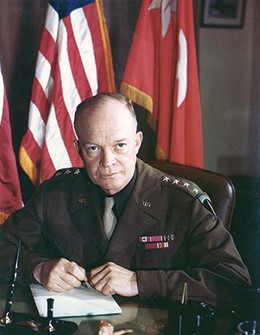11 Chapter 11: Franklin Roosevelt, the New Deal, and the Second World War, 1932-1945
Franklin Roosevelt, the New Deal, and the Second World War, 1932-1945

President Roosevelt’s Federal One Project allowed thousands of artists to create public art. This initiative was a response to the Great Depression as part of the Works Project Administration, and much of the public art in cities today date from this era. New Deal by Charles Wells can be found in the Clarkson S. Fisher Federal Building and U.S. Courthouse in Trenton, New Jersey. Source: Wikimedia Commons
Chapter Outline
Introduction, Watch and Learn, Questions to Guide Your Reading
11.1 The Rise of Franklin Roosevelt
11.2 The First New Deal
11.3 The Second New Deal
11.4 The Origins of War: Europe, Asia, and the United States
11.5 The Home Front
11.6 Victory in the European Theater
11.7 The Pacific Theater and the Atomic Bomb
Summary Timelines, Chapter 11 Self-Test, Chapter 11 Key Terms Crossword Puzzle
Introduction
The election of President Franklin Delano Roosevelt signaled immediate relief for the American public as well as a permanent shift in the role of the federal government in guiding the economy and providing direct assistance to the people. For many, the immediate relief was, at a minimum, psychological: Herbert Hoover was gone, and the situation could not grow worse under Roosevelt. But as his New Deal unfolded, Americans learned more about the fundamental changes their new president brought with him to the Oval Office. In the span of little more than one hundred days, the country witnessed a wave of legislation never seen before or since.
Roosevelt understood the need to “save the patient,” to borrow a medical phrase he often employed, as well as to “cure the ill.” This meant both creating jobs, through such programs as the Works Progress Administration, which provided employment to over eight million Americans, as well as reconfiguring the structure of the American economy. In pursuit of these two goals, Americans re-elected Roosevelt for three additional terms in the White House and became full partners in the reshaping of their country.
During Roosevelt’s terms in office, the European continent erupted into what is known as World War II. This War awakened the sleeping giant of the United States from the lingering effects of the Great Depression. Although the country had not entirely disengaged itself from foreign affairs following World War I, it had remained largely divorced from events occurring in Europe until the late 1930s. World War II forced the United States to involve itself once again in European affairs. It also helped to relieve the unemployment of the 1930s and stir industrial growth. The propaganda poster to the right was part of a concerted effort to get Americans to see themselves as citizens of a strong, unified country, dedicated to the protection of freedom and democracy. However, the war that unified many Americans also brought to the fore many of the nation’s racial and ethnic divisions, both on the frontlines—where military units, such as the one depicted in this poster, were segregated by race—and on the home front. Yet, the war also created new opportunities for ethnic minorities and women, which, in postwar America, would contribute to their demand for greater rights.

During World War II, American propaganda was used to drum up patriotism and support for the war effort. This poster shows the grit and determination of infantrymen in the face of enemy fire. Source: Wikimedia Commons
Watch and Learn (Crash Course in History videos for chapter 11)
Questions to Guide Your Reading
- To what extent was Franklin Roosevelt’s overwhelming victory in the 1932 presidential election a reflection of his own ideas for change? To what extent did it represent public discontent with Herbert Hoover’s lack of answers?
- Whom did the New Deal help the least? What hardships did these individuals continue to suffer? Why were Roosevelt’s programs unsuccessful in the alleviation of their adversities?
- Was Franklin Roosevelt successful at combating the Great Depression? How did the New Deal affect future generations of Americans?
- What challenges did Roosevelt face in his work on behalf of African Americans? What impact did the New Deal have ultimately on race relations?
- Given that the Japanese war against China began in 1937 and German aggression began in Europe in 1936, why did United States wait until 1941 to join the war against the Axis powers? Was the decision to stay out of the war until 1941 a wise one on the part of the United States?
- Should the United States have done more to help European Jews during the 1930s? What could it have done?
- In what ways did World War II improve the status of women and African Americans in the United States?
- Should the U.S. government have ordered the internment of Japanese Americans? Does the fear of espionage or sabotage justify depriving American citizens of their rights?
- Did the United States make the right decision to drop atomic bombs on Japan?
11.1 The Rise of Franklin Roosevelt
Learning Objectives
By the end of this section, you should be able to:
- Describe the events of the 1932 presidential election and identify the characteristics that made Franklin Roosevelt a desirable candidate
Franklin Roosevelt was part of the political establishment and the wealthy elite, but in the 1932 presidential campaign, he did not want to be perceived that way. Roosevelt felt that the country needed sweeping change, and he ran a campaign intended to convince the American people that he could deliver that change. Roosevelt campaigned tirelessly, talking to thousands of people, appearing at his party’s national convention, and striving to show the public that he was a different breed of politician.

Franklin Roosevelt brought a new feeling of optimism and possibility to a country that was beaten down by hardship. His enthusiasm was in counterpoint to Herbert Hoover’s discouraging last year in office. Source: Wikimedia Commons
THE ELECTION OF FRANKLIN ROOSEVELT
By the 1932 presidential election, Hoover’s popularity was at an all-time low. Despite his efforts to address the hardships that many Americans faced, his ineffectual response to the Great Depression left Americans angry and ready for change. Franklin Roosevelt, though born to wealth and educated at the best schools, offered the change people sought. The election results that November were never really in question: With three million more people voting than in 1928, Roosevelt won by a popular count of twenty-three million to fifteen million. He carried all but six states while winning over 57 percent of the popular vote.
Roosevelt exuded confidence, which the American public desperately wished to see in their leader. And, despite his affluence, Americans felt that he could relate to their suffering due to his own physical hardships; he had been struck with polio a decade earlier and was essentially paralyzed from the waist down for the remainder of his life. Roosevelt understood that the public sympathized with his ailment; he likewise developed a genuine empathy for public suffering as a result of his illness. Roosevelt also recognized the need to convey to the voting public that he was not simply another member of the political aristocracy. Roosevelt sought to show that he was different—that he could defy expectations—and through his actions could find creative solutions to address the nation’s problems while restoring public confidence in fundamental American values.

Roosevelt’s inauguration was considered by people at the time to be a day of new beginnings for the country. The sun breaking through the clouds as he was being sworn in became a metaphor for the hope that people felt at his presidency. Source: Wikimedia Commons
INAUGURATION DAY: A NEW BEGINNING
March 4, 1933, dawned gray and rainy. Roosevelt rode in an open car as he made his way to the U.S. Capitol. At the ceremony, Roosevelt rose with the aid of leg braces equipped under his specially tailored trousers and placed his hand on a Dutch family Bible as he took his solemn oath. At that very moment, the rain stopped, and the sun began to shine directly on the platform, and those present would later claim that it was as though God himself was shining down on Roosevelt and the American people in that moment. Bathed in the sunlight, Roosevelt delivered one of the most famous and oft-quoted inaugural addresses in history. He encouraged Americans to work with him to find solutions to the nation’s problems and not to be paralyzed by fear into inaction. Roosevelt called upon all Americans to assemble and fight an essential battle against the forces of economic depression. He famously stated, “The only thing we have to fear is fear itself.”
11.1 Section Summary
Franklin Roosevelt was a wealthy, well-educated, and popular politician whose history of polio made him a more sympathetic figure to the public. He did not share any specifics of his plan to bring the country out of the Great Depression, but his attitude of optimism and possibility contrasted strongly with Hoover’s defeated misery. The 1932 election was never really in question, and Roosevelt won in a landslide. During the four-month interregnum, however, Americans continued to endure President Hoover’s failed policies, which led the winter of 1932–1933 to be the worst of the Depression, with unemployment rising to record levels. When Roosevelt took office in March 1933, he infused the country with a sense of optimism. He still did not have a formal plan but rather invited the American people to join him in the spirit of experimentation. Roosevelt did bring certain beliefs to office: the belief in an active government that would take direct action on federal relief, public works, social services, and direct aid to farmers. But as much as his policies, Roosevelt’s own personality and engaging manner helped the country feel that they were going to get back on track.
11.2 The First New Deal
Learning Objectives
By the end of this section, you should be able to:
- Identify the key pieces of legislation included in Roosevelt’s “First New Deal”
- Assess the strengths, weaknesses, and general effectiveness of the First New Deal
- Explain Roosevelt’s overall vision for addressing the structural problems in the U.S. economy
Roosevelt began his administration with a broad strategy in mind: a combination of relief and recovery programs designed to first save the patient (in this case, the American people), and then to find a long-term cure (reform through federal regulation of the economy). What later became known as the “First New Deal” ushered in a wave of legislative activity seldom before seen in the history of the country. By the close of 1933, in an effort to stem the crisis, Congress had passed over fifteen significant pieces of legislation—many of the circulated bills allegedly still wet with ink from the printing presses as members voted upon them. Most bills could be grouped around issues of relief, recovery, and reform. At the outset of the First New Deal, specific goals included 1) bank reform; 2) job creation; 3) economic regulation; and 4) regional planning.
REFORM: THE BANKING CRISIS
When Roosevelt took office, he faced one of the worst moments in the country’s banking history. States were in disarray. In all, over five thousand banks had been shuttered. Within forty-eight hours of his inauguration, Roosevelt proclaimed an official bank holiday and called Congress into a special session to address the crisis. The resulting Emergency Banking Act of 1933 was signed into law on March 9, 1933, a scant eight hours after Congress first saw it. By March 15, 70 percent of the banks were declared solvent and allowed to reopen.
On March 12, the day before the banks were set to reopen, Roosevelt held his first “fireside chat.” In this initial radio address to the American people, he explained what the bank examiners had been doing over the previous week. He assured people that any bank open the next day had the federal government’s stamp of approval. The combination of his reassuring manner and the promise that the government was addressing the problems worked wonders in changing the popular mindset. Just as the culture of panic had contributed to the country’s downward spiral after the crash, so did this confidence inducing move help to build it back up. Consumer confidence returned, and within weeks, close to $1 billion in cash and gold had been brought out from under mattresses and hidden bookshelves and redeposited in the nation’s banks. The immediate crisis had been quelled, and the public was ready to believe in their new president.

Roosevelt’s “fireside chats” provided an opportunity for him to speak directly to the American people, and the people were happy to listen. These radio addresses, commemorated at the Franklin D. Roosevelt Memorial in Washington, DC, with this bronze sculpture by George Segal, contributed to Roosevelt’s tremendous popularity. Source: Wikimedia Commons
In June 1933, Roosevelt replaced the Emergency Banking Act with the more permanent Glass-Steagall Banking Act. This law prohibited commercial banks from engaging in investment banking, therefore stopping the practice of banks speculating in the stock market with deposits. This law also created the Federal Deposit Insurance Corporation, or FDIC, which insured personal bank deposits up to $2,500. Other measures designed to boost confidence in the overall economy beyond the banking system included passage of the Economy Act, which fulfilled Roosevelt’s campaign pledge to reduce government spending by reducing salaries, including his own and those of the Congress. He also signed into law the Securities Act, which required full disclosure to the federal government from all corporations and investment banks that wanted to market stocks and bonds. Roosevelt also sought new revenue through the Beer Tax. As the Twenty-First Amendment, which would repeal the Eighteenth Amendment establishing Prohibition, moved towards ratification, this law authorized the manufacture of 3.2 percent beer and levied a tax on it.
|
|
DEFINING “AMERICAN” |
|
The Power of Hearth and Home Fireside chats—Roosevelt’s weekly radio addresses—underscored Roosevelt’s savvy in understanding how best to reach people. Using simple terms and a reassuring tone, he invoked a family patriarch sitting by the fire, explaining to those who trusted him how he was working to help them. It is worth noting how he explained complex financial concepts quite simply, but at the same time, complimented the American people on their “intelligent support.” One of his fireside chats is provided below: I recognize that the many proclamations from State capitols and from Washington, the legislation, the Treasury regulations, etc., couched for the most part in banking and legal terms, should be explained for the benefit of the average citizen. I owe this in particular because of the fortitude and good temper with which everybody has accepted the inconvenience and hardships of the banking holiday. I know that when you understand what we in Washington have been about I shall continue to have your cooperation as fully as I have had your sympathy and help during the past week. . . . The success of our whole great national program depends, of course, upon the cooperation of the public—on its intelligent support and use of a reliable system. . . . After all, there is an element in the readjustment of our financial system more important than currency, more important than gold, and that is the confidence of the people. Confidence and courage are the essentials of success in carrying out our plan. You people must have faith; you must not be stampeded by rumors or guesses. Let us unite in banishing fear. We have provided the machinery to restore our financial system; it is up to you to support and make it work. It is your problem no less than it is mine. Together we cannot fail. —Franklin D. Roosevelt, March 12, 1933 A huge part of Roosevelt’s success in turning around the country can be seen in his addresses like these: He built support and galvanized the public. Ironically, Roosevelt, the man who famously said we have nothing to fear but fear itself, had a significant fear: fire. Being paralyzed with polio, he was very afraid of being left near a fireplace. But he knew the power of the hearth and home, and drew on this mental image to help the public view him the way that he hoped to be seen. |
|
THE FIRST HUNDRED DAYS
In his first hundred days in office, the new president pushed forward an unprecedented number of new bills, all geared towards stabilizing the economy, providing relief to individuals, creating jobs, and helping businesses. A sympathetic Democrat-controlled Congress helped propel his agenda forward.
Relief: Employment for the Masses
Even as he worked to rebuild the economy, Roosevelt recognized that the unemployed millions required jobs more quickly than the economy could provide. In a push to create new jobs, Roosevelt signed the Wagner-Peyser Act, creating the United States Employment Service, which promised states matching funds if they created local employment opportunities. He also authorized $500 million in direct grants through the Federal Emergency Relief Act (FERA). This money went directly to states to infuse relief agencies with the much-needed resources to help the nearly fifteen million unemployed. These two bills illustrate Roosevelt’s dual purposes of providing short-term emergency help and building employment opportunities that would strengthen the economy in the long term.
Roosevelt mostly wanted to create more jobs. FERA overseer Harry Hopkins, who later was in charge of the Civil Works Administration (CWA), shared this sentiment. With Hopkins at its helm, the CWA, founded in early 1933, went on to put millions of men and women to work. At its peak, there were some four million Americans repairing bridges, building roads and airports, and undertaking other public projects. Another work program was the Civilian Conservation Corps Relief Act (CCC). The CCC provided government jobs for young men aged fourteen to twenty-four who came from relief families. They would earn thirty dollars per month planting trees, fighting forest fires, and refurbishing historic sites and parks, building an infrastructure that families would continue to enjoy for generations to come. Within the first two months, the CCC employed its first 250,000 men and eventually established about twenty-five hundred camps.
The final element of Roosevelt’s efforts to provide relief to those in desperate straits was the Home Owners’ Refinancing Act. Created by the Home Owners’ Loan Corporation (HOLC), the program rescued homeowners from foreclosure by refinancing their mortgages. Not only did this save the homes of countless homeowners, but it also saved many of the small banks who owned the original mortgages by relieving them of the refinancing responsibility. Later New Deal legislation created the Federal Housing Authority, which eventually standardized the thirty-year mortgage and promoted the housing boom of the post-World War II era. A similar program, created through the Emergency Farm Mortgage Act and Farm Credit Act, provided the same service for farm mortgages.

The CCC put hundreds of thousands of men to work on environmental projects around the country as illustrated in this picture of workers in Eastern Oregon. Source: Wikimedia Commons
The various programs that made up the First New Deal are listed in the table below:
|
Table 11.1 Key Programs from the First New Deal |
||
|
New Deal Legislation |
Years Enacted |
Brief Description |
|
Agricultural Adjustment Administration |
1933–1935 |
Farm program designed to raise process by curtailing production |
|
Civil Works Administration |
1933–1934 |
Temporary job relief program |
|
Civilian Conservation Corps |
1933–1942 |
Employed young men to work in rural areas |
|
Farm Credit Administration |
1933-today |
Low interest mortgages for farm owners |
|
Federal Deposit Insurance Corporation |
1933–today |
Insure private bank deposits |
|
Federal Emergency Relief Act |
1933 |
Direct monetary relief to poor unemployed Americans |
|
Glass-Steagall Act |
1933 |
Regulate investment banking |
|
Homeowners Loan Corporation |
1933–1951 |
Government mortgages that allowed people to keep their homes |
|
Indian Reorganization Act |
1933 |
Abandoned federal policy of assimilation |
|
National Recovery Administration |
1933–1935 |
Industries agree to codes of fair practice to set price, wage, production levels |
|
Public Works Administration |
1933–1938 |
Large public works projects |
|
Resettlement Administration |
1933–1935 |
Resettles poor tenant farmers |
|
Securities Act of 1933 |
1933–today |
Created SEC; regulates stock transactions |
|
Tennessee Valley Authority |
1933–today |
Regional development program; brought electrification to the valley |
|
|
||
Rescuing Farms and Factories
While much of the legislation of the first hundred days focused on immediate relief and job creation through federal programs, Roosevelt was committed to addressing the underlying problems inherent in the American economy. In his efforts to do so, he created two of the most significant pieces of New Deal legislation: the Agricultural Adjustment Act (AAA) and the National Industry Recovery Act (NIRA).
Farms around the country were suffering, but from different causes. In the Great Plains, drought conditions meant that little was growing at all, while in the South, bumper crops and low prices meant that farmers could not sell their goods at prices that could sustain them. The AAA paid southern farmers to reduce their production: wheat, cotton, corn, hogs, tobacco, rice, and milk farmers were all eligible. Passed into law on May 12, 1933, it was designed to boost prices to a level that would alleviate rural poverty and restore profitability to American agriculture. This was a bold attempt to help farmers address the systemic problems of overproduction and lower commodity prices.

Sharecroppers and tenant farmers suffered enormously during the Great Depression. Many farmers ending up taking to the road, along with other Dust Bowl refugees, on their way to California. Source: Wikimedia Commons
While Roosevelt hoped the AAA would help farms and farmers, he also sought aid for the beleaguered manufacturing sector. A new government agency, the National Recovery Administration (NRA), was central to this plan, and mandated that businesses accept a code that included minimum wages and maximum work hours. In order to protect workers from potentially unfair agreements among factory owners, every industry had its own “code of fair practice” that included workers’ rights to organize and use collective bargaining to ensure that wages rose with prices.
The NIRA also created the Public Works Administration (PWA). The PWA set aside $3.3 billion to build public projects such as highways, federal buildings, and military bases. Although this program suffered from political squabbles over appropriations for projects in various congressional districts, as well as significant underfunding of public housing projects, it ultimately offered some of the most lasting benefits of the NIRA. Secretary of the Interior Harold Ickes ran the program, which completed over thirty-four thousand projects, including the Golden Gate Bridge in San Francisco and the Queens-Midtown Tunnel in New York. Between 1933 and 1939, the PWA accounted for the construction of over one-third of all new hospitals and 70 percent of all new public schools in the country.
Although Roosevelt’s relief efforts provided jobs to many and benefitted communities with the construction of several essential building projects, the violence that erupted amid clashes between organized labor and factories backed by police and the authorities exposed a fundamental flaw in the president’s approach. Immediate relief did not address long-existing, inherent class inequities that left workers exposed to poor working conditions, low wages, long hours, and little protection. For many workers, life on the job was not much better than life as an unemployed American. Employment programs may have put men back to work and provided much needed relief, but the fundamental flaws in the system required additional attention—attention that Roosevelt was unable to pay in the early days of the New Deal. Critics were plentiful, and the president would be forced to address them in the years ahead.

Consumers were encouraged to buy from companies displaying the Blue Eagle (a), the logo signifying compliance with the new NRA regulations. With talons gripping a gear, representing industry, and lightning bolts, representing power, the eagle (b) was intended to be a symbol of economic recovery. Source: Wikimedia Commons
Regional Planning
Regionally, Roosevelt’s work was most famously seen in the Tennessee Valley Authority (TVA), a federal agency tasked with the job of planning and developing the area through flood control, reforestation, and hydroelectric power. Employing several thousand Americans on a project that Roosevelt envisioned as a template for future regional redevelopment, TVA workers erected a series of dams to harness the Tennessee River in the creation of much-needed hydroelectric power. The arrival of both electric lighting and machinery to the region eased the lives of the people who lived there, as well as encouraged industrial growth. The TVA also included an educational component, teaching farmers important lessons about crop rotation, soil replenishment, fertilizing, and reforestation. Throughout his presidency, Roosevelt frequently pointed to the TVA as one of the glowing accomplishments of the New Deal and its ability to bring together the machinery of the federal government along with private interests to revitalize a regional economy.
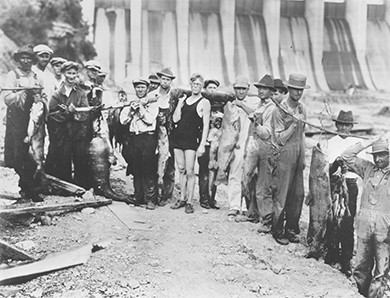
The TVA helped a struggling part of the country through the creation of jobs, and flood control and reforestation programs. The Wilson Dam, shown here, is one of nine TVA dams on the Tennessee River. Source: Wikimedia Commons
11.2 Section Summary
After assuming the presidency, Roosevelt lost no time in taking bold steps to fight back against the poverty and unemployment plaguing the country. He immediately created a bank holiday and used the time to bring before Congress legislation known as the Emergency Banking Act, which allowed federal agencies to examine all banks before they reopened, thus restoring consumer confidence. He then went on, in his historic first hundred days, to sign numerous other significant pieces of legislation that were geared towards creating jobs, shoring up industry and agriculture, and providing relief to individuals through both refinancing options and direct handouts. Not all of his programs were effective, and many generated significant criticism. Overall, however, these programs helped to stabilize the economy, restore confidence, and change the pessimistic mindset that had overrun the country.
11.3 The Second New Deal
Learning Objectives
By the end of this section, you should be able to:
- Identify key pieces of legislation from the Second New Deal
- Assess the entire New Deal, especially in terms of its impact on women, African Americans, and Native Americans
Roosevelt won his second term in a landslide, but that did not mean he was immune to criticism. His critics came from both the left and the right. Adding to Roosevelt’s challenges, the Supreme Court struck down several key elements of the First New Deal, angering Roosevelt and spurring him to try and stack the courts in his second term. Still, he entered his new term with the unequivocal support of the voting public, and he wasted no time beginning the second phase of his economic plan. While the First New Deal focused largely on stemming the immediate suffering of the American people, the Second New Deal put in place legislation that changed America’s social safety net for good.
CHALLENGES FROM CRITICS ON ALL SIDES
While many people supported Roosevelt, especially in the first few years of his presidency, the New Deal did receive significant criticism, both from conservatives who felt that it was a radical agenda to ruin the country’s model of free enterprise, and from liberals who felt that it did not provide enough help to those who needed it most.
Industrialists and wealthy Americans led the conservative criticism against the president. Whether attacking his character or simply stating that he was moving away from American values toward fascism and socialism, they sought to undermine his power and popularity. In 1935, the U.S. Supreme Court dealt the most crushing blow to Roosevelt’s vision, striking down several key pieces of the New Deal as unconstitutional. They found that both the AAA and the NIRA overreached federal authority. The negation of some of his most ambitious economic recovery efforts frustrated Roosevelt greatly, but he was powerless to stop it at this juncture.
Meanwhile, others felt that Roosevelt had not done enough. Dr. Francis E. Townsend of California was one who felt that Roosevelt had failed to adequately address the country’s tremendous problems. Townsend, who was a retired dentist, proposed an expansive pension plan for the elderly. The Townsend Plan, as it was known, gained a great deal of popularity: It recommended paying every citizen over sixty who retired from work the sum of $200 per month, provided they spend it in thirty days. Another figure who gained national attention was Father Charles Coughlin. He was a “radio priest” from Michigan who, although he initially supported the New Deal, subsequently argued that Roosevelt stopped far too short in his defense of labor, monetary reform, and the nationalization of key industries. The president’s plan, he proclaimed, was inadequate. He created the National Union for Social Justice and used his weekly radio show to gain followers.

Roosevelt used previously unheard-of levels of government power in his attempt to push the country out of the Great Depression, as artist Joseph Parrish depicts here in this 1937 Chicago Tribune cartoon. While critics on the left felt that he had not done enough, critics on the right felt that his use of power was frighteningly close to fascism and socialism. Source: Wikimedia Commons
The biggest threat to the president, however, came from corrupt but beloved Louisiana senator Huey “Kingfish” Long. His disapproval of Roosevelt came in part from his own ambitions for higher office; Long stated that the president was not doing enough to help people and proposed his own Share Our Wealth program. Under this plan, Long recommended the liquidation of all large personal fortunes in order to fund direct payments to less fortunate Americans. He foresaw giving $5,000 to every family, $2,500 to every worker, as well as a series of elderly pensions and education funds. By 1935, Long had a significant following of over four million people. If he had not been assassinated by the son-in-law of a local political rival, he may well have been a contender against Roosevelt for the 1936 presidential nomination.
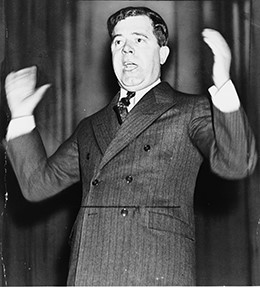
Huey P. Long was a charismatic populist and governor of Louisiana from 1928 to 1932. In 1932, he became a member of the U.S. Senate and would have been a serious rival for Roosevelt in the 1936 presidential election if his life had not been cut short by an assassin’s bullet. Source: Wikimedia Commons
ANSWERING THE CHALLENGE
Roosevelt recognized that some of the criticisms of the New Deal were valid. Although he was still reeling from the Supreme Court’s invalidation of key statutes, he decided to face his re-election bid in 1936 by unveiling another wave of legislation that he dubbed the Second New Deal. Whereas the policies of the first hundred days may have shored up public confidence and stopped the most drastic of the problems, the second hundred days changed the face of America for the next sixty years.
The Banking Act of 1935 was the most far-reaching revision of banking laws since the creation of the Federal Reserve System in 1914. Previously, regional reserve banks, particularly the New York Reserve Bank—controlled by the powerful Morgan and Rockefeller families—had dominated policymaking at the Federal Reserve. Under the new system, there would be a seven-member board of governors to oversee regional banks. They would have control over reserve requirements, discount rates, board member selection, and more.
In 1935, Congress also passed the Emergency Relief Appropriation Act, which authorized the single largest expenditure at that time in the country’s history: $4.8 billion. Almost one-third of those funds were invested in a new relief agency, the Works Progress Administration (WPA). Between 1935 and 1945, the program provided employment relief to over eight million Americans, or approximately 20 percent of the country’s workforce. The WPA funded the construction of more than 2,500 hospitals, 5,900 schools, 570,000 miles of road, and more. The WPA also created the Federal One Project, which employed approximately forty thousand artists in theater, art, music, and writing. They produced state murals, guidebooks, concerts, and drama performances all around the country. Additionally, the project funded the collection of oral histories, including those of former slaves, which provided a valuable addition to the nation’s understanding of slave life. Finally, the WPA also included the National Youth Administration (NYA), which provided work-study jobs to over 500,000 college students and four million high school students.

Painted by artists funded by the Federal One Project, this section of Ohio, a mural located in the Bellevue, Ohio post office, illustrates a busy industrial scene. Artists painted the communities where they lived, thus creating visions of farms, factories, urban life, harvest celebrations, and more that still reflect the life and work of that era. Source: Wikimedia Commons
With the implementation of the Second New Deal, Roosevelt also created the country’s present-day social safety net. The Social Security Act established programs intended to help the most vulnerable: the elderly, the unemployed, the disabled, and the young. It included a pension fund for all retired people—except domestic workers and farmers, which therefore left many women and African Americans beyond the scope of its benefits—over the age of sixty-five, to be paid through a payroll tax on both employee and employer. Related to this act, Congress also passed a law on unemployment insurance, to be funded by a tax on employers, and programs for unwed mothers, as well as for those who were blind, deaf, or disabled.
The various programs that made up the Second New Deal are listed in the table below.
|
Key Programs from the Second New Deal |
||
|
New Deal Legislation |
Years Enacted |
Brief Description |
|
Fair Labor Standards Act |
1938–today |
Established minimum wage and forty-hour workweek |
|
Farm Security Administration |
1935–today |
Provides poor farmers with education and economic support programs |
|
Federal Crop Insurance Corporation |
1938–today |
Insures crops and livestock against loss of revenue |
|
National Labor Relations Act |
1935–today |
Recognized right of workers to unionize & collectively bargain |
|
National Youth Administration |
1935–1939 (part of WPA) |
Part-time employment for college and high school students |
|
Rural Electrification Administration |
1935–today |
Provides public utilities to rural areas |
|
Social Security Act |
1935–today |
Aid to retirees, unemployed, disabled |
|
Surplus Commodities Program |
1936–today |
Provides food to the poor (still exists in Food Stamps program) |
|
Works Progress Administration |
1935–1943 |
Jobs program (including artists and youth) |
THE FINAL PIECES
Roosevelt signed the last substantial piece of New Deal legislation in the summer of 1938. The Fair Labor Standards Act established a federal minimum wage—at the time, forty cents per hour—a maximum workweek of forty hours (with an opportunity for four additional hours of work at overtime wages) and prohibited child labor for those under age sixteen. The legacy of the New Deal is in part seen in the vast increase in national power: The federal government accepted responsibility for the nation’s economic stability and prosperity. In retrospect, the majority of historians and economists judge it to have been a tremendous success. The New Deal not only established minimum standards for wages, working conditions, and overall welfare, it also allowed millions of Americans to hold onto their homes, farms, and savings. It laid the groundwork for an agenda of expanded federal government influence over the economy that continued through President Harry Truman’s “Fair Deal” in the 1950s and President Lyndon Johnson’s call for a “Great Society” in the 1960s.
IN THE FINAL ANALYSIS
The legacy of the New Deal is in part seen in the vast increase in national power: The federal government accepted responsibility for the nation’s economic stability and prosperity. In retrospect, the majority of historians and economists judge it to have been a tremendous success. The New Deal not only established minimum standards for wages, working conditions, and overall welfare, it also allowed millions of Americans to hold onto their homes, farms, and savings. It laid the groundwork for an agenda of expanded federal government influence over the economy that continued through President Harry Truman’s “Fair Deal” in the 1950s and President Lyndon Johnson’s call for a “Great Society” in the 1960s. The New Deal state that embraced its responsibility for the citizens’ welfare and proved willing to use its power and resources to spread the nation’s prosperity lasted well into the 1980s, and many of its tenets persist today. Many would also agree that the postwar economic stability of the 1950s found its roots in the stabilizing influences introduced by social security, the job stability that union contracts provided, and federal housing mortgage programs introduced in the New Deal. The environment of the American West in particular, benefited from New Deal projects such as the Soil Conservation program.
African Americans under the New Deal
Critics point out that not all Americans benefited from the New Deal. African Americans in particular were left out, with overt discrimination in hiring practices within the federal job programs, such as the CCC, CWA, and WPA. The NRA was oftentimes criticized as the “Negro Run Around” or “Negroes Ruined Again” program. As well, the AAA left tenant farmers and sharecroppers, many of whom were black, with no support. Even Social Security originally excluded domestic workers, a primary source of employment for African American women. Facing such criticism early in his administration, Roosevelt undertook some efforts to ensure a measure of equality in hiring practices for the relief agencies, and opportunities began to present themselves by 1935. The WPA eventually employed 350,000 African Americans annually, accounting for nearly 15 percent of its workforce. By the close of the CCC in 1938, this program had employed over 300,000 African Americans, increasing the black percentage of its workforce from 3 percent at the outset to nearly 11 percent at its close. Likewise, in 1934, the PWA began to require that all government projects under its purview hire African Americans using a quota that reflected their percentage of the local population being served. Additionally, among several important WPA projects, the Federal One Project included a literacy program that eventually reached over one million African American children, helping them learn how to read and write.
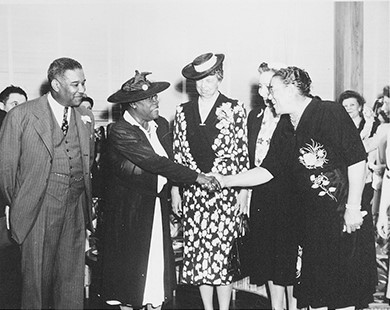
This photo of Eleanor Roosevelt and Mary McLeod Bethune (second from left) was taken at the opening of Midway Hall, a federal building to house female African American government workers. Bethune was sometimes criticized for working with those in power, but her willingness to build alliances contributed to success in raising money and support for her causes. Source: Wikimedia Commons
On the issue of race relations themselves, Roosevelt has a mixed legacy. Within his White House, Roosevelt had a number of African American appointees, although most were in minor positions. Unofficially, Roosevelt relied upon advice from the Federal Council on Negro Affairs, also known as his “Black Cabinet.” This group included a young Harvard economist, Dr. Robert Weaver, who subsequently became the nation’s first black cabinet secretary in 1966, as President Lyndon Johnson’s Secretary of Housing and Urban Development. Aubrey Williams, the director of the NYA, hired more black administrators than any other federal agency, and appointed them to oversee projects throughout the country. One key figure in the NYA was Mary McLeod Bethune, a prominent African American educator tapped by Roosevelt to act as the director of the NYA’s Division of Negro Affairs. Bethune had been a spokesperson and an educator for years; with this role, she became one of the president’s foremost African American advisors. During his presidency, Roosevelt became the first to appoint a black federal judge, as well as the first commander-in-chief to promote an African American to brigadier general. Most notably, he became the first president to publicly speak against lynching as a “vile form of collective murder.”
However, despite these efforts, Roosevelt also understood the precariousness of his political position. In order to maintain a coalition of Democrats to support his larger relief and recovery efforts, Roosevelt could not afford to alienate Southern Democrats who might easily bolt should he openly advocate for civil rights. While he spoke about the importance of anti-lynching legislation, he never formally pushed Congress to propose such a law. He did publicly support the abolition of the poll tax, which Congress eventually accomplished in 1941. Likewise, although agency directors adopted changes to ensure job opportunities for African Americans at the federal level, at the local level, few advancements were made, and African Americans remained at the back of the employment lines. Despite such failures, however, Roosevelt deserves credit for acknowledging the importance of race relations and civil rights. At the federal level, more than any of his predecessors since the Civil War, Roosevelt remained aware of the role that the federal government can play in initiating important discussions about civil rights, as well as encouraging the development of a new cadre of civil rights leaders.
|
|
MY STORY |
|
Mary McLeod Bethune on Racial Justice Democracy is for me, and for twelve million black Americans, a goal towards which our nation is marching. It is a dream and an ideal in whose ultimate realization we have a deep and abiding faith. For me, it is based on Christianity, in which we confidently entrust our destiny as a people. Under God’s guidance in this great democracy, we are rising out of the darkness of slavery into the light of freedom. Here my race has been afforded [the] opportunity to advance from a people 80 percent illiterate to a people 80 percent literate; from abject poverty to the ownership and operation of a million farms and 750,000 homes; from total disfranchisement to participation in government; from the status of chattels to recognized contributors to the American culture. When Mary McLeod Bethune spoke these words, she spoke on behalf of a race of American citizens for whom the Great Depression was much more than economic hardship. For African Americans, the Depression once again exposed the racism and inequality that gripped the nation economically, socially, and politically. Her work as a member of President Franklin Roosevelt’s unofficial “Black Cabinet” as well as the Director of the Division of Negro Affairs for the NYA, presented her an opportunity to advance African American causes on all fronts—but especially in the area of black literacy. |
|
Women and the New Deal
For women, Roosevelt’s policies and practices had a similarly mixed effect. Wage discrimination in federal jobs programs was rampant, and relief policies encouraged women to remain home and leave jobs open for men. This belief was well in line with the gender norms of the day. Several federal relief programs specifically forbade husbands and wives’ both drawing jobs or relief from the same agency. The WPA became the first specific New Deal agency to openly hire women—specifically widows, single women, and the wives of disabled husbands. While they did not take part in construction projects, these women did undertake sewing projects to provide blankets and clothing to hospitals and relief agencies. Likewise, several women took part in the various Federal One art projects.
Among the few, but notable, women who directly impacted Roosevelt’s policies was Frances Perkins, who as Secretary of Labor was the first female member of any presidential cabinet, and First Lady Eleanor Roosevelt, who was a strong and public advocate for social causes. Perkins, one of only two original Cabinet members to stay with Roosevelt for his entire presidency, was directly involved in the administration of the CCC, PWA, NRA, and the Social Security Act. Among several important measures, she took greatest pleasure in championing minimum wage statutes as well as the penultimate piece of New Deal legislation, the Fair Labor Standards Act.
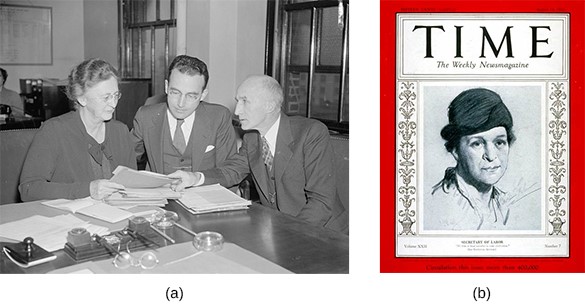
After leaving her post as head of the Women’s Division of the Democratic Party, Molly Dewson (a) later accepted an appointment to the Social Security Board, working with fellow board members Arthur J. Altmeyer and George E. Bigge, shown here in 1937. Another influential advisor to President Franklin Roosevelt was Frances Perkins (b), who, as U.S. Secretary of Labor, graced the cover of Time magazine on August 14, 1933. Source: Wikimedia Commons
|
|
DEFINING “AMERICAN” |
|
Molly Dewson and Women Democrats In her effort to get President Roosevelt re-elected in 1936, Dewson commented, “We don’t make the old-fashioned plea to the women that our nominee is charming, and all that. We appeal to the intelligence of the country’s women. Ours were economic issues and we found the women ready to listen.” As head of the Women’s Division of the Democratic National Committee (DNC) in 1932, Molly Dewson proved to be an influential supporter of President Franklin Roosevelt and one of his key advisors regarding issues pertaining to women’s rights. Agreeing with First Lady Eleanor Roosevelt that “Women must learn to play the games as men do,” Dewson worked diligently in her position with the DNC to ensure that women could serve as delegates and alternates to the national conventions. Her approach, and her realization that women were intelligent enough to make rational choices, greatly appealed to Roosevelt. Her methods were perhaps not too different from his own, as he spoke to the public through his fireside chats. Dewson’s impressive organizational skills on behalf of the party earned her the nickname “the little general” from President Roosevelt. |
|
Eleanor Roosevelt, more so than any other individual, came to represent the strongest influence upon the president; and she used her unique position to champion several causes for women, African Americans, and the rural poor. A strong supporter of her husband’s political ambitions, Eleanor campaigned by his side through the failed vice-presidential bid in 1920 and on his behalf after he was diagnosed with polio in 1921.
Historians agree that the first lady used her presence in the White House, in addition to the leverage of her failed marriage and knowledge of her husband’s infidelities, to her advantage. She promoted several causes that the president himself would have had difficulty championing at the time. From newspaper and magazine articles she authored, to a busy travel schedule that saw her regularly cross the country, the first lady sought to remind Americans that their plight was foremost on the minds of all working in the White House. Eleanor was so active in her public appearances that, by 1940, she began holding regular press conferences to answer reporters’ questions.
Eleanor supported many civil rights causes through the remainder of the Roosevelt presidency. When it became clear that racial discrimination was rampant in the administration of virtually all New Deal job programs—especially in the southern states—she continued to pressure her husband for remedies. Breaking with precedent, and much to the disdain of many White House officials, the first lady routinely invited prominent African Americans to dine with her and the president. Most notably, when the Daughters of the American Revolution (DAR) refused to permit internationally renowned black opera contralto Marian Anderson to sing in Constitution Hall, Eleanor resigned her membership in the DAR and arranged for Anderson to sing at a public concert on the steps of the Lincoln Memorial, followed by her appearance at a state dinner at the White House in honor of the king and queen of England. With regard to race relations in particular, Eleanor Roosevelt was able to accomplish what her husband—for delicate political reasons—could and/or would not: become the administration’s face for civil rights.
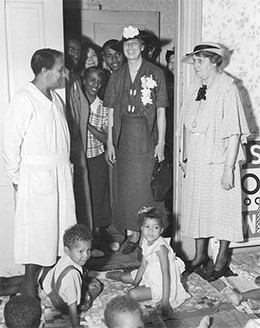
Eleanor Roosevelt travelled the country to promote New Deal programs. Here she visits a WPA nursery school in Des Moines, Iowa, on June 8, 1936. Source: Wikimedia Commons
The Indian New Deal
Roosevelt worked with Congress to improve the lives of Native Americans. In 1934, he signed into law the Indian Reorganization Act (sometimes referred to as the “Indian New Deal”). This law formally abandoned the assimilationist policies set forth in the Dawes Severalty Act of 1887. Rather than forcing them to adapt to American culture, the new program encouraged Native peoples to develop forms of local self-government, as well as to preserve their artifacts and heritage. The major goal was to reverse the traditional goal of assimilation of Indians into American society and to strengthen, encourage and perpetuate the tribes and their historic traditions and culture.
The Act also restored to Indians the management of their assets—land and mineral rights—and included provisions intended to create a sound economic foundation for the inhabitants of Indian reservations. The act slowed the practice of allotting communal tribal lands to individual tribal members. It did not restore to Indians land that had already been patented to individuals. And, because the Act did not disturb existing private ownership of Indian reservation lands, it left reservations as a checkerboard of tribal or individual trust and fee land, which remains the case today. Finally, the law did not apply to Hawaii; Alaska and Oklahoma were added under another law in 1936. The census counted 332,000 Indians in 1930 and 334,000 in 1940, including those on and off reservations in the 48 states.
John Collier, the Commissioner on Indian Bureau Affairs from 1933 to 1945, championed this legislation and saw it as an opportunity to correct past injustices that land allotment and assimilation had wrought upon Indians. Although the re-establishment of communal tribal lands would prove to be difficult, Collier used this law to convince federal officials to return nearly two million acres of government-held land to various tribes in order to move the process along. Although subsequent legislation later circumscribed the degree to which tribes were allowed to self-govern on reservations, Collier’s work is still viewed as a significant step in improving race relations with Indians and preserving their heritage.
|
|
DEFINING “AMERICAN” |
|
Differing Views Native Americans were divided on the success of the Indian Reorganizational Act (also known as the Wheeler-Howard Act). The Act required Indian tribes to vote whether to accept it. 172 tribes accepted it while 73 did not. Opinions were divided in terms of its impact on Native peoples as the following excerpts reveal. In a 1970 interview, Sioux tribal leader Alfred DuBray argued that the Indian New Deal, on balance, brought positive change: It had a lot of advantages that many of the people didn’t see, such as making loan funds available, huge amounts of that. Farm programs were developed through this. Cattle-raising programs were initiated. Educational loans were beginning to be made available for Indian youngsters who had never had any opportunities before, hardly, to attend any higher institutions. Unless they just did it by sheer initiative, and if somebody is sponsoring it. So there was a new field there in education, and, of course, mainly the tribal governing body section of it—busy there, and they established their governing body and voted on their representatives and the council members. In another 1970 interview, Amos Owen, Mdewakanton Sioux tribal chairman, gave a mixed verdict: It didn’t pan out as we thought it was going to be. Of course, I was pretty young at the time, but I remember when we first organized, the Wheeler-Howard Act was I guess originally the way it was written up, it was really good. If the Indians made a little money or they became more prosperous as a community, they could, in turn, buy up more land. That was the way the Wheeler-Howard Act was written up. And before it went through Congress, I guess, it was revised a bit so that buying back land was struck out of some of the papers it was drawn up on. I don’t know how this came about, but it wasn’t in the charter and the constitution and bylaws when the thing came into effect. So we done it; I can’t just go out and say the Bureau of Indian Affairs done it. But they didn’t believe in colonies like ours, a small community like ours buying back land that originally belonged to us anyway. And finally, in 1968, Ramon Roubideaux, a Brule Sioux, categorically denounced the Act: I might say as far as the Indian Reorganization Act is concerned, I think this is possibly one of the best intentioned but unfortunate happenings that could have possibly taken place as far as the Indian people are concerned. … So what this has really done, it has substituted in place of the governing system that the Indians had prior to the Indian Reorganization Act, a white man’s idea of how they should live … In the first place, it set the Indian aside as a problem. The Indian is, was told that he was a problem from the very day that he was born under this system and as he grew older, he was by the presence of these so-called experts in agriculture and ranching and other activities they were paying lip service to teaching the Indians, he was somehow made to feel that he was inferior, that he wasn’t able to compete. So that the whole system emphasized the activities of the Indians as a whole for the benefit of the whole, rather than the individual uh, private enterprise system of our American system. He wasn’t taught to be a capitalist, which he must be taught in order for him to survive in, in this country. |
|
IN THE FINAL ANALYSIS
The legacy of the New Deal is in part seen in the vast increase in national power: The federal government accepted responsibility for the nation’s economic stability and prosperity. In retrospect, the majority of historians and economists judge it to have been a tremendous success. The New Deal not only established minimum standards for wages, working conditions, and overall welfare, it also allowed millions of Americans to hold onto their homes, farms, and savings. It laid the groundwork for an agenda of expanded federal government influence over the economy that continued through President Harry Truman’s “Fair Deal” in the 1950s and President Lyndon Johnson’s call for a “Great Society” in the 1960s. The New Deal state that embraced its responsibility for the citizens’ welfare and proved willing to use its power and resources to spread the nation’s prosperity lasted well into the 1980s, and many of its tenets persist today. Many would also agree that the postwar economic stability of the 1950s found its roots in the stabilizing influences introduced by social security, the job stability that union contracts provided, and federal housing mortgage programs introduced in the New Deal. The environment of the American West in particular, benefited from New Deal projects such as the Soil Conservation program.
11.3 Section Summary
Despite his popularity, Roosevelt had significant critics at the end of the First New Deal. Some on the right felt that he had moved the country in a dangerous direction towards socialism and fascism, whereas others on the left felt that he had not gone far enough to help the still-struggling American people. Roosevelt pushed Congress to pass a new wave of bills to provide jobs, banking reforms, and a social safety net. The laws that emerged—the Banking Act, the Emergency Relief Appropriation Act, and the Social Security Act—still define our country today. Roosevelt won his second term in a landslide and continued to push for legislation that would help the economy. The jobs programs employed over eight million people and, while systematic discrimination hurt both women and African American workers, these programs were still successful in getting people back to work. The last major piece of New Deal legislation that Roosevelt passed was the Fair Labor Standards Act, which set a minimum wage, established a maximum-hour workweek, and forbade child labor. This law, as well as Social Security, still provides much of the social safety net in the United States today. Roosevelt’s presidency expanded the role of the federal government in all people’s lives, generally for the better. Even if the most conservative of presidential successors would question this commitment, the notion of some level of government involvement in economic regulation and social welfare had largely been settled by 1941. Future debates would be about the extent and degree of that involvement.
11.4 The Origins of War: Europe, Asia, and the United States
Learning Objectives
By the end of this section, you will be able to:
- Discuss the events in Europe and Asia that led to the start of the war
- Identify the early steps taken by President Franklin D. Roosevelt to increase American aid to nations fighting totalitarianism while maintaining neutrality
The changes that were occurring in the United States in the 1930s were paralleled by changes in other parts of the world. Much had changed between the end of World War I and the beginning of World War II. The Russian Revolution of 1917, Germany’s defeat in World War I, and the subsequent Treaty of Versailles had broken up the Austro-Hungarian, German, and Russian empires and significantly redrew the map of Europe. At the same time, much of the world was dealing with economic and political crises, and different types of totalitarian regimes began to take hold in Europe. In Asia, an ascendant Japan began to expand its borders. Although the United States remained focused on the economic challenges of the Great Depression as World War II approached, ultimately it became clear that American involvement in the fight against Nazi Germany and Japan was in the nation’s interest.
THE MARCH TOWARD WAR
While the United States focused on domestic issues, economic depression and political instability were growing in Europe. The crash of 1929, when the U.S. stock market plummeted and American capital dried-up, set-in motion a series of financial chain reactions that contributed significantly to a global downward economic spiral. Around the world, industrialized economies faced significant problems of economic depression and worker unemployment.
Totalitarianism in Europe
Many European countries had been suffering even before the Great Depression began. A postwar recession and the continuation of wartime inflation had hurt many economies, as did a decrease in agricultural prices, which made it harder for farmers to buy manufactured goods or pay off loans to banks. In such an unstable environment, Benito Mussolini capitalized on the frustrations of the Italian people who felt betrayed by the Versailles Treaty. Mussolini and his followers embraced Fascism, which called for a totalitarian form of government and a heightened focus on national unity, militarism, social Darwinism, and loyalty to the state. Between 1925 and 1927, Mussolini transformed Italy into a single party state and removed all restraints on his power.
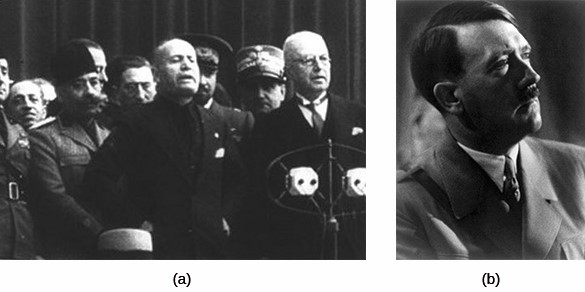
Italian Fascists under the dictatorial leadership of Benito Mussolini (a, center) and German National Socialist Party leader and dictator Adolf Hitler (b) systematically dismantled democratic institutions and pushed military buildups, racial supremacy, and an aggressive nationalism in the 1920s and early 1930s. Source: Wikimedia Commons
In Germany, a similar pattern led to the rise of the totalitarian National Socialist Party—the Nazis. The Nazis gained numerous followers during the Great Depression, which hurt Germany tremendously, plunging it further into economic crisis. Hitler, a World War I veteran, promised to return Germany to greatness. By the beginning of 1933, the Nazis had become the largest party in the German legislature. In the elections that took place in early March 1933, the Nazis gained the political power to pass the Enabling Act later that same month, which gave Hitler the power to make all laws for the next four years. Hitler thus effectively became the dictator of Germany and remained so long after the four-year term passed. Like Italy, Germany had become a one-party totalitarian state. Nazi Germany was an anti-Semitic nation, and in 1935, the Nuremberg Laws deprived Jews, whom Hitler blamed for Germany’s downfall, of German citizenship and the rights thereof.
Once in power, Hitler began to rebuild German military might. He commenced his program by withdrawing Germany from the League of Nations in October 1933. In 1936, in accordance with his promise to restore German greatness, Hitler dispatched military units into the Rhineland, on the border with France, which was an act contrary to the provisions of the Versailles Treaty. In March 1938, claiming that he sought only to reunite ethnic Germans within the borders of one country, Hitler invaded Austria. Germany occupied the rest of Czechoslovakia as well.
Japan
Militaristic politicians also took control of Japan in the 1930s. The Japanese had worked assiduously for decades to modernize, build their strength, and become a prosperous, respected nation. The sentiment in Japan was decidedly pro-capitalist, and the Japanese militarists were fiercely supportive of a capitalist economy. They viewed with great concern the rise of Communism in the Soviet Union and in particular China, where the issue was fueling a civil war, and feared that the Soviet Union would make inroads in Asia by assisting China’s Communists. The Japanese militarists thus found a common ideological enemy with Fascism and National Socialism, which had based their rise to power on anti-Communist sentiments. In 1936, Japan and Germany signed the Anti-Comintern Pact, pledging mutual assistance in defending themselves against the Comintern, the international agency created by the Soviet Union to promote worldwide Communist revolution. In 1937, Italy joined the pact, essentially creating the foundation of what became the military alliance of the Axis powers.
FROM NEUTRALITY TO ENGAGEMENT
President Franklin Roosevelt was aware of the challenges facing the targets of Nazi aggression in Europe and Japanese aggression in Asia. Although he hoped to offer U.S. support, Congress’s commitment to nonintervention was difficult to overcome. Roosevelt’s willingness to accede to the demands of the noninterventionists led him even to refuse assistance to those fleeing Nazi Germany. Although Roosevelt was aware of Nazi persecution of the Jews, he did little to aid them. In a symbolic act of support, he withdrew the American ambassador to Germany in 1938. He did not press for a relaxation of immigration quotas that would have allowed more refugees to enter the country, however. In 1939, he refused to support a bill that would have admitted twenty thousand Jewish refugee children to the United States. Again in 1939, when German refugees aboard the SS St. Louis, most of them Jews, were refused permission to land in Cuba and turned to the United States for help, the U.S. State Department informed them that immigration quotas for Germany had already been filled. Once again, Roosevelt did not intervene, because he feared that nativists in Congress might smear him as a friend of Jews.
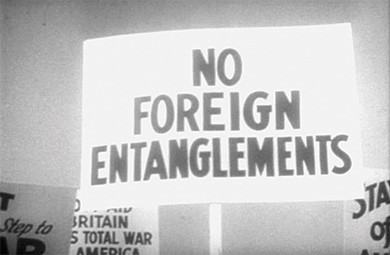
This protest sign shows the unwillingness of many Americans to become involved in a foreign war. Source: Wikimedia Commons
War Begins in Europe
On September 1, 1939, Hitler unleashed his Blitzkrieg, or “lightning war,” against Poland, using swift, surprise attacks combining infantry, tanks, and aircraft to quickly overwhelm the enemy. On September 3, 1939, Britain and France declared war on Germany, and the European phase of World War II began. When the Germans commenced their spring offensive in 1940, they defeated France in six weeks with a highly mobile and quick invasion of France, Belgium, Luxembourg, and the Netherlands. In the Far East, Japan took advantage of France’s surrender to Germany to occupy French Indochina. In response, beginning with the Export Control Act in July 1940, the United States began to embargo the shipment of various materials to Japan, starting first with aviation gasoline and machine tools, and proceeding to scrap iron and steel.
The Atlantic Charter
Following the surrender of France, the Battle of Britain began, as Germany proceeded to try to bomb England into submission. As the battle raged in the skies over Great Britain throughout the summer and autumn of 1940, became increasingly concerned over England’s ability to hold out against the German juggernaut. In June 1941, Hitler marched his armies deep into Soviet territory, where they would kill Red Army regulars and civilians by the millions until their advances were stalled and ultimately reversed by the devastating battle of Stalingrad, which took place from August 23, 1942 until February 2, 1943 when, surrounded and out of ammunition, the German 6th army surrendered.
In August 1941, Roosevelt met with the British prime minister, Winston Churchill, off the coast of Newfoundland, Canada. At this meeting, the two leaders drafted the Atlantic Charter, the blueprint of Anglo-American cooperation during World War II. The charter stated that the United States and Britain sought no territory from the conflict. It proclaimed that citizens of all countries should be given the right of self-determination, self-government should be restored in places where it had been eliminated, and trade barriers should be lowered. Further, the charter mandated freedom of the seas, renounced the use of force to settle international disputes, and called for postwar disarmament.
In March 1941, concerns over Britain’s ability to defend itself also influenced Congress to authorize a policy of Lend Lease, a practice by which the United States could sell, lease, or transfer armaments to any nation deemed important to the defense of the United States. Lend Lease effectively ended the policy of nonintervention and dissolved America’s pretense of being a neutral nation. The program ran from 1941 to 1945 and distributed some $45 billion worth of weaponry and supplies to Britain, the Soviet Union, China, and other allies.
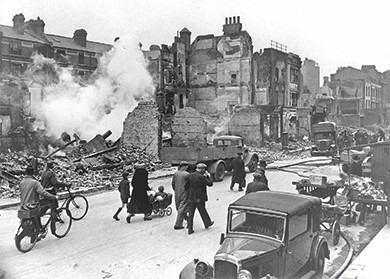
London and other major British cities suffered extensive damaged from the bombing raids of the Battle of Britain. Over one million London houses were destroyed or damaged during “The Blitz” and almost twenty thousand Londoners were killed. Source: Wikimedia Commons
A Date Which Will Live in Infamy
By the second half of 1941, Japan was feeling the pressure of the American embargo. As it could no longer buy strategic material from the United States, the Japanese were determined to obtain a sufficient supply of oil by taking control of the Dutch East Indies. However, they realized that such an action might increase the possibility of American intervention, since the Philippines, a U.S. territory, lay on the direct route that oil tankers would have to take to reach Japan from Indonesia. Japanese leaders thus attempted to secure a diplomatic solution by negotiating with the United States while also authorizing the navy to plan for war. The Japanese government also decided that if no peaceful resolution could be reached by the end of November 1941, then the nation would have to go to war against the United States.
The American final counterproposal to various offers by Japan was for the Japanese to completely withdraw, without any conditions, from China and enter into nonaggression pacts with all the Pacific powers. Japan found that proposal unacceptable but delayed its rejection for as long as possible. Then, at 7:48 a.m. on Sunday, December 7, the Japanese attacked the U.S. Pacific fleet at anchor in Pearl Harbor, Hawaii. They launched two waves of attacks from six aircraft carriers that had snuck into the central Pacific without being detected. The attacks brought some 353 fighters, bombers, and torpedo bombers down on the unprepared fleet. The Japanese hit all eight battleships in the harbor and sank four of them. They also damaged several cruisers and destroyers. On the ground, nearly two hundred aircraft were destroyed, and twenty-four hundred servicemen were killed. Another eleven hundred were wounded.
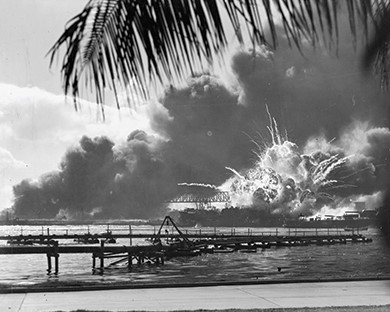
This famous photograph captured the explosion of the USS Shaw after the Japanese bombed Pearl Harbor. While American losses were significant, the Japanese lost only twenty-nine planes and five miniature submarines. Source: Wikimedia Commons
Whatever reluctance to engage in conflict the American people had had before December 7, 1941, quickly evaporated. Americans’ incredulity that Japan would take such a radical step quickly turned to a fiery anger. President Roosevelt, referring to the day of the attack as “a date which will live in infamy,” asked Congress for a declaration of war, which it delivered to Japan on December 8. On December 11, Germany and Italy declared war on the United States in accordance with their alliance with Japan. Against its wishes, the United States had become part of the European conflict.
11.4 Section Summary
America sought, at the end of the First World War, to create new international relationships that would make such wars impossible in the future. But as the Great Depression hit Europe, several new leaders rose to power under the new political ideologies of Fascism and Nazism. Mussolini in Italy and Hitler in Germany were both proponents of Fascism, using dictatorial rule to achieve national unity. Still, the United States remained focused on the economic challenges of its own Great Depression. Hence, there was little interest in getting involved in Europe’s problems or even the China-Japan conflict. It soon became clear, however, that Germany and Italy’s alliance was putting democratic countries at risk. Roosevelt first sought to support Great Britain and China by providing economic support without intervening directly. However, when Japan, an ally of Germany and Italy, attacked Pearl Harbor, catching the military base unaware and claiming thousands of lives, America’s feelings toward war shifted, and the country was quickly pulled into the global conflict.
11.5 The Home Front
Learning Objectives
By the end of this section, you will be able to:
- Discuss the contributions of civilians on the home front, especially women, to the war effort
- Analyze how the war affected race relations in the United States
The impact of the war on the United States was nowhere near as devastating as it was in Europe and the Pacific, where the battles were waged, but it still profoundly changed everyday life for all Americans. On the positive side, the war effort finally and definitively ended the economic depression that had been plaguing the country since 1929. It also called upon Americans to unite behind the war effort and give of their money, their time, and their effort, as they sacrificed at home to assure success abroad. The upheaval caused by white men leaving for war meant that for many disenfranchised groups, such as women and African Americans, there were new opportunities in employment and wage earning. Still, fear and racism drove cracks in the nation’s unified facade.
MOBILIZING A NATION
In order to fight a war, the country needed to build an army. A peacetime draft, the first in American history, had been established in September 1940, but the initial draftees were to serve for only one year, a length of time that was later extended. Furthermore, Congress had specified that no more than 900,000 men could receive military training at any one time. By December 1941, the United States had only one division completely ready to be deployed. Military planners estimated that it might take nine million men to secure victory. A massive draft program was required to expand the nation’s military forces. Over the course of the war, approximately fifty million men registered for the draft; ten million were subsequently inducted into the service.
Approximately 2.5 million African Americans registered for the draft, and 1 million of them served. Initially, African American soldiers, who served in segregated units, had been used as support troops and not been sent into combat. By the end of the war, however, manpower needs resulted in African American recruits serving in the infantry and flying planes. The Tuskegee Institute in Alabama had instituted a civilian pilot training program for aspiring African American pilots. When the war began, the Department of War absorbed the program and adapted it to train combat pilots. First Lady Eleanor Roosevelt demonstrated both her commitment to African Americans and the war effort by visiting Tuskegee in 1941, shortly after the unit had been organized. To encourage the military to give the airmen a chance to serve in actual combat, she insisted on taking a ride in a plane flown by an African American pilot to demonstrate the Tuskegee Airmen’s skill. When the Tuskegee Airmen did get their opportunity to serve in combat, they did so with distinction.
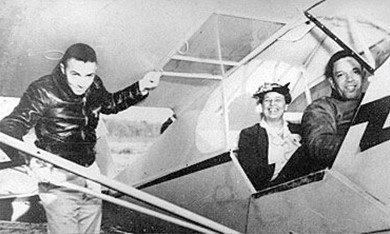
First Lady Eleanor Roosevelt insisted on flying with an African American pilot to help fight racism in the military. The First Lady was famous for her support of civil rights. Source: Wikimedia Commons
In addition, forty-four thousand Native Americans served in all theaters of the war. In the Pacific campaigns, Native Americans made distinct and unique contributions to Allied victories. Navajo marines served in communications units, exchanging information over radios using codes based on their native language, which the Japanese were unable to comprehend or to crack. They became known as code talkers and participated in the battles of Guadalcanal, Iwo Jima, Peleliu, and Tarawa. A smaller number of Comanche code talkers performed a similar function in the European theater.
While millions of Americans heeded the rallying cry for patriotism and service, there were those who, for various reasons, did not accept the call. During the war, approximately seventy-two thousand men registered as conscientious objectors (COs), and fifty-two thousand were granted that status. Of that fifty-two thousand, some accepted noncombat roles in the military, whereas others accepted unpaid work in civilian work camps. Many belonged to pacifist religious sects such as the Quakers or Mennonites. They were willing to serve their country, but they refused to kill. COs suffered public condemnation for disloyalty, and family members often turned against them. Strangers assaulted them. A portion of the town of Plymouth, NH, was destroyed by fire because the residents did not want to call upon the services of the COs trained as firemen at a nearby camp. Only a very small number of men evaded the draft completely.
EMPLOYMENT AND MIGRATION PATTERNS IN THE UNITED STATES
Even before the official beginning of the war, the country started to prepare. In August 1940, Congress created the Defense Plant Corporation, which had built 344 plants in the West by 1945 and had funneled over $1.8 billion into the economies of western states. After Pearl Harbor, as American military strategists began to plan counterattacks and campaigns against the Axis powers, California became a training ground.
As thousands of Americans swarmed to the West Coast to take jobs in defense plants and shipyards, cities like Richmond, California, and nearby Oakland, expanded quickly. Richmond grew from a city of 20,000 people to 100,000 in only three years. Almost overnight, the population of California skyrocketed. African Americans moved out of the rural South into northern or West Coast cities to provide the muscle and skill to build the machines of war. Building on earlier waves of African American migration after the Civil War and during World War I, the demographics of the nation changed with the growing urbanization of the African American population. Women also relocated to either follow their husbands to military bases or take jobs in the defense industry, as the total mobilization of the national economy began to tap into previously underemployed populations.
As in World War I, the government turned to bond drives to finance the war. Millions of Americans purchased more than $185 billion worth of war bonds. Children purchased Victory Stamps and exchanged full stamp booklets for bonds. The federal government also instituted the current tax-withholding system to ensure collection of taxes. Finally, the government once again urged Americans to plant victory gardens, using marketing campaigns and celebrities to promote the idea. Americans responded eagerly, planting gardens in their backyards and vacant lots.

Wartime rationing meant that Americans had to do without many everyday items and learn to grow their own produce in order to allow the country’s food supply to go to the troops. Source: Wikimedia Commons
The federal government also instituted rationing to ensure that America’s fighting men were well fed. Civilians were issued ration booklets, books of coupons that enabled them to buy limited amounts of meat, coffee, butter, sugar, and other foods. Other items were rationed as well, including shoes, liquor, cigarettes, and gasoline. With a few exceptions, such as doctors, Americans were allowed to drive their automobiles only on certain days of the week. Civilians on the home front recycled, conserved, and participated in scrap drives to collect items needed for the production of war materiel. Housewives saved cooking fats, needed to produce explosives. Children collected scrap metal, paper, rubber, silk, nylon, and old rags. Some children sacrificed beloved metal toys in order to “win the war.” Civilian volunteers, trained to recognize enemy aircraft, watched the skies along the coasts and on the borders.
WOMEN IN THE WAR: ROSIE THE RIVETER AND BEYOND
As in the previous war, the gap in the labor force created by departing soldiers meant opportunities for women. In particular, World War II led many to take jobs in defense plants and factories around the country. For many women, these jobs provided unprecedented opportunities to move into occupations previously thought of as exclusive to men, especially the aircraft industry, where a majority of workers were composed of women by 1943. Most women in the labor force did not work in the defense industry, however. The majority took over other factory jobs that had been held by men. Many took positions in offices as well. As white women, many of whom had been in the workforce before the war, moved into these more highly paid positions, African American women, most of whom had previously been limited to domestic service, took over white women’s lower-paying positions in factories; some were also hired by defense plants, however. Although women often earned more money than ever before, it was still far less than men received for doing the same jobs. Nevertheless, many achieved a degree of financial self-reliance that was enticing. By 1944, as many as 33 percent of the women working in the defense industries were mothers and worked “double-day” shifts—one at the plant and one at home.
Still, there was some resistance to women going to work in such a male-dominated environment. In order to recruit women for factory jobs, the government created a propaganda campaign centered on a now iconic figure known as Rosie the Riveter. Rosie, who was a composite based on several real women, was most famously depicted by American illustrator Norman Rockwell. Rosie was tough yet feminine. To reassure men that the demands of war would not make women too masculine, some factories gave female employees lessons in how to apply makeup, and cosmetics were never rationed during the war.
Although many saw the entry of women into the workforce as a positive thing, they also acknowledged that working women, especially mothers, faced great challenges. To try to address the dual role of women as workers and mothers, Eleanor Roosevelt urged her husband to approve the first U.S. government childcare facilities under the Community Facilities Act of 1942. Eventually, seven centers, servicing 105,000 children, were built. The First Lady also urged industry leaders like Henry Kaiser to build model childcare facilities for their workers. Still, these efforts did not meet the full need for childcare for working mothers.
The lack of childcare facilities meant that many children had to fend for themselves after school, and some had to assume responsibility for housework and the care of younger siblings. Some mothers took younger children to work with them and left them locked in their cars during the workday. Police and social workers also reported an increase in juvenile delinquency during the war. New York City saw its average number of juvenile cases balloon from 9,500 in the prewar years to 11,200 during the war. In San Diego, delinquency rates for girls, including sexual misbehavior, shot up by 355 percent. It is unclear whether more juveniles were actually engaging in delinquent behavior; the police may simply have become more vigilant during wartime and arrested youngsters for activities that would have gone overlooked before the war. In any event, law enforcement and juvenile courts attributed the perceived increase to a lack of supervision by working mothers.
Tens of thousands of women served in the war effort more directly. Approximately 350,000 joined the military. They worked as nurses, drove trucks, repaired airplanes, and performed clerical work to free up men for combat. Those who joined the Women’s Airforce Service Pilots (WASPs) flew planes from the factories to military bases. Some of these women were killed in combat and captured as prisoners of war. Over sixteen hundred of the women nurses received various decorations for courage under fire. Many women also flocked to work in a variety of civil service jobs. Others worked as chemists and engineers, developing weapons for the war. This included thousands of women who were recruited to work on the Manhattan Project, developing the atomic bomb.
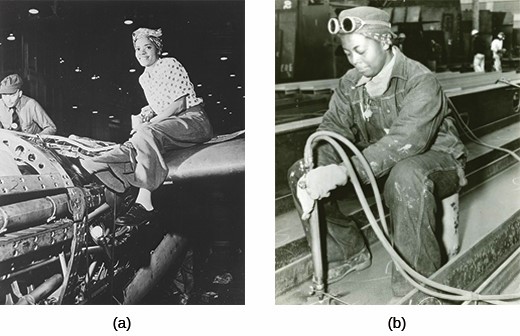
“Rosie the Riveter” became a generic term for all women working in the defense industry. Although the Rosie depicted on posters was white, many of the real Rosies were African American, such as this woman who poses atop an airplane at the Lockheed Aircraft Corporation in Burbank, California (a), and Anna Bland, a worker at the Richmond Shipyards (b). Source: Wikimedia Commons
THE CULTURE OF WAR: ENTERTAINERS AND THE WAR EFFORT
During the Great Depression, movies had served as a welcome diversion from the difficulties of everyday life, and during the war, this held still truer. By 1941, there were more movie theaters than banks in the United States. In the 1930s, newsreels, which were shown in movie theaters before feature films, had informed the American public of what was happening elsewhere in the world. Many informational documentaries about the war were shown in movie theaters. The most famous were those in the Why We Fight series, filmed by Hollywood director Frank Capra. During the war, Americans flocked to the movies not only to learn what was happening to the troops overseas but also to be distracted from the fears and hardships of wartime by cartoons, dramas, and comedies. By 1945, movie attendance had reached an all-time high.
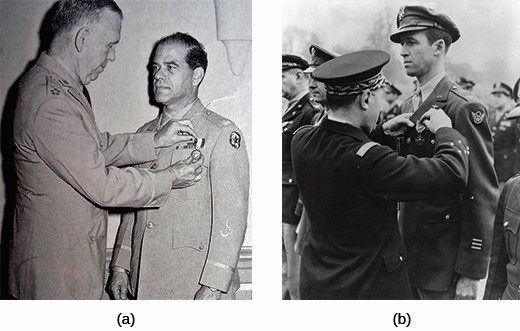
General George Marshall awards Frank Capra the Distinguished Service Cross in 1945 (a), in recognition of the important contribution that Capra’s films made to the war effort. Jimmy Stewart was awarded numerous commendations for his military service, including the French Croix de Guerre (b). Source: Wikimedia Commons
SOCIAL TENSIONS ON THE HOME FRONT
The need for Americans to come together, whether in Hollywood, the defense industries, or the military, to support the war effort encouraged feelings of unity among the American population. However, the desire for unity did not always mean that Americans of color were treated as equals or even tolerated, despite their proclamations of patriotism and their willingness to join in the effort to defeat America’s enemies in Europe and Asia. For African Americans, Mexican Americans, and especially for Japanese Americans, feelings of patriotism and willingness to serve one’s country both at home and abroad was not enough to guarantee equal treatment by white Americans or to prevent the U.S. government from regarding them as the enemy.
African Americans and Double V
The African American community had, at the outset of the war, forged some promising relationships with the Roosevelt administration through civil rights activist Mary McLeod Bethune and Roosevelt’s “Black Cabinet” of African American advisors. Through the intervention of Eleanor Roosevelt, Bethune was appointed to the advisory council set up by the War Department Women’s Interest Section. In this position, Bethune was able to organize the first officer candidate school for women and enable African American women to become officers in the Women’s Auxiliary Corps.
As the U.S. economy revived as a result of government defense contracts, African Americans wanted to ensure that their service to the country earned them better opportunities and more equal treatment. Accordingly, in 1942, after African American labor leader A. Philip Randolph pressured Roosevelt with a threatened “March on Washington,” the president created, by Executive Order 8802, the Fair Employment Practices Committee. The purpose of this committee was to see that there was no discrimination in the defense industries. While they were effective in forcing defense contractors, such as the DuPont Corporation, to hire African Americans, they were not able to force corporations to place African Americans in well-paid positions. For example, at DuPont’s plutonium production plant in Hanford, Washington, African Americans were hired as low-paid construction workers but not as laboratory technicians.
During the war, the Congress of Racial Equality (CORE), founded by James Farmer in 1942, used peaceful civil disobedience in the form of sit-ins to desegregate certain public spaces in Washington, DC, and elsewhere, as its contribution to the war effort. Members of CORE sought support for their movement by stating that one of their goals was to deprive the enemy of the ability to generate anti-American propaganda by accusing the United States of racism. After all, they argued, if the United States were going to denounce Germany and Japan for abusing human rights, the country should itself be as exemplary as possible. Indeed, CORE’s actions were in keeping with the goals of the Double V campaign. The campaign called upon African Americans to accomplish the two “Vs”: victory over America’s foreign enemies and victory over racism in the United States.
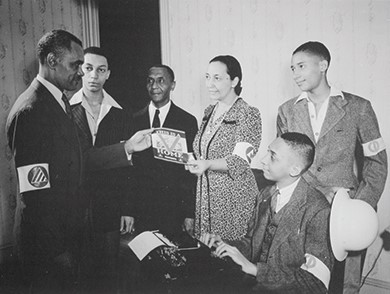
During World War II, African Americans volunteered for government work just as white Americans did. These Washington, DC, residents have become civil defense workers as part of the Double V campaign that called for victory at home and abroad. Source: Wikimedia Commons
Despite the willingness of African Americans to fight for the United States, racial tensions often erupted in violence, as the geographic relocation necessitated by the war brought African Americans into closer contact with whites. There were race riots in Detroit, Harlem, and Beaumont, Texas, in which white residents responded with sometimes deadly violence to their new black coworkers or neighbors. There were also racial incidents at or near several military bases in the South. Incidents of African American soldiers being harassed or assaulted occurred at Fort Benning, Georgia; Fort Jackson, South Carolina; Alexandria, Louisiana; Fayetteville, Arkansas; and Tampa, Florida.
|
|
DEFINING “AMERICAN” |
|
The Double V Campaign In January 1942, James G. Thompson, wrote a letter to the African American newspaper The Pittsburgh Courier in which he reflected upon the dilemma that he and other black people faced as they contemplated what their role in the Second World War would be: Being an American of dark complexion and some 26 years, these questions flash through my mind: Should I sacrifice my life to live half American? Will things be better for the next generation in the peace to follow? Would it be demanding too much to demand full citizenship rights in exchange for the sacrificing of my life? Is the kind of America I know worth defending? Will America be a true and pure democracy after the war? Will Colored Americans suffer still the indignities that have been heaped upon them in the past? These and other questions need answering; I want to know, and I believe every colored American, who is thinking, wants to know… The V for victory sign is being displayed prominently in all so–called democratic countries which are fighting for victory over aggression, slavery, and tyranny. If this V sign means that to those now engaged in this great conflict, then let we colored Americans adopt the double V V for a double victory. The first V for victory over our enemies from without, the second V for victory over our enemies from within. For surely those who perpetrate these ugly prejudices here are seeking to destroy our democratic form of government just as surely as the Axis forces. |
|
The Zoot Suit Riots
Mexican Americans also encountered racial prejudice. The Mexican American population in Southern California grew during World War II due to the increased use of Mexican agricultural workers in the fields to replace the white workers who had left for better paying jobs in the defense industries. The United States and Mexican governments instituted the “bracero” program on August 4, 1942, which sought to address the needs of California growers for manual labor to increase food production during wartime. The result was the immigration of thousands of impoverished Mexicans into the United States to work as braceros, or manual laborers.
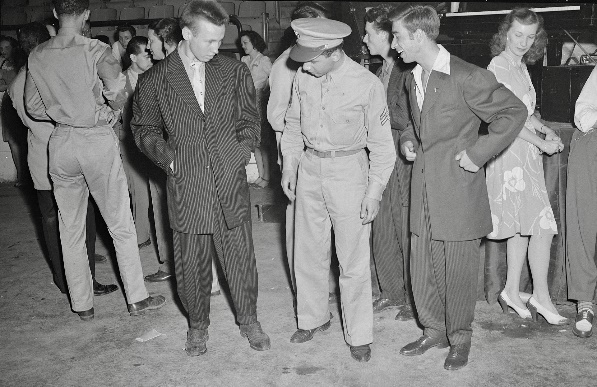
A soldier stands between two men wearing zoot suits in Los Angeles. Source: Wikimedia Commons
Forced by racial discrimination to live in the barrios of East Los Angeles, many Mexican American youths sought to create their own identity and began to adopt a distinctive style of dress known as zoot suits, which were also popular among many young African American men. The zoot suits, which required large amounts of cloth to produce, violated wartime regulations that restricted the amount of cloth that could be used in civilian garments. Among the charges leveled at young Mexican Americans was that they were un-American and unpatriotic; wearing zoot suits was seen as evidence of this. In the summer of 1943, “zoot-suit riots” occurred in Los Angeles when carloads of white sailors, encouraged by other white civilians, stripped and beat a group of young men wearing the distinctive form of dress. In retaliation, young Mexican American men attacked and beat up sailors. The response was swift and severe, as sailors and civilians went on a spree attacking young Mexican Americans on the streets, in bars, and in movie theaters. More than one hundred people were injured.
Japanese Internment
Japanese Americans also suffered from discrimination. The Japanese attack on Pearl Harbor unleashed a cascade of racist assumptions about Japanese immigrants and Japanese Americans in the United States that culminated in the relocation and internment of 120,000 people of Japanese ancestry, 66 percent of whom had been born in the United States. Executive Order 9066, signed by Roosevelt on February 19, 1942, gave the army power to remove people from “military areas” to prevent sabotage or espionage.
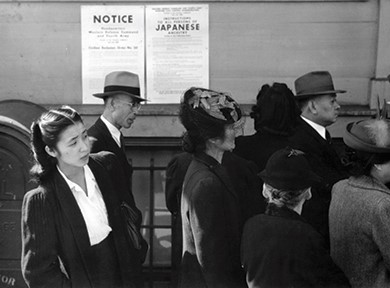
Americans standing in line in front of a poster detailing internment orders in California. Source: Wikimedia Commons
After the order went into effect, Lt. General John L. DeWitt, in charge of the Western Defense command, ordered approximately 127,000 Japanese and Japanese Americans—roughly 90 percent of those of Japanese ethnicity living in the United States—to assembly centers where they were transferred to hastily prepared camps in the interior of California, Arizona, Colorado, Utah, Idaho, Wyoming, and Arkansas). Those who were sent to the camps reported that the experience was deeply traumatic. Families were sometimes separated. People could only bring a few of their belongings and had to abandon the rest of their possessions. The camps themselves were dismal and overcrowded. Although a study commissioned earlier by Roosevelt indicated that there was little danger of disloyalty on the part of West Coast Japanese, fears of sabotage, perhaps spurred by the attempted rescue of a Japanese airman shot down at Pearl Harbor by Japanese living in Hawaii, and racist sentiments led Roosevelt to act. No interned Japanese Americans were found guilty of sabotage or espionage.
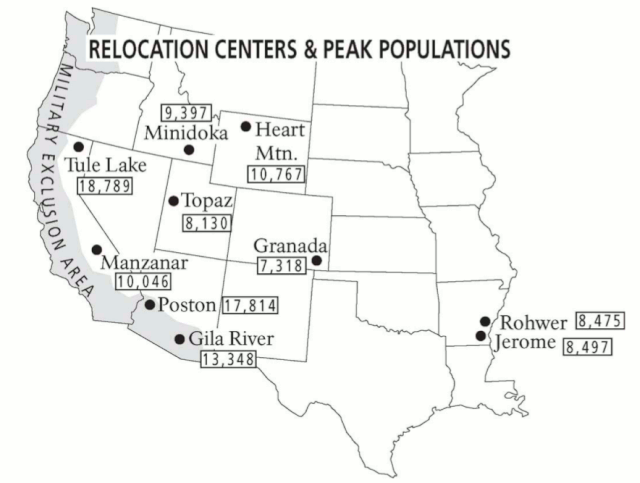
This map shows the location of Japanese Interment Centers in the American West. Source: Wikimedia Commons
11.5 Section Summary
The brunt of the war’s damage occurred far from United States soil, but Americans at home were still greatly affected by the war. Women struggled to care for children with scarce resources at their disposal and sometimes while working full time. Economically, the country surged forward, but strict rationing for the war effort meant that Americans still went without. New employment opportunities opened up for women and ethnic minorities, as white men enlisted or were drafted. These new opportunities were positive for those who benefited from them, but they also created new anxieties among white men about racial and gender equality. Race riots took place across the country, and Americans of Japanese ancestry were relocated to internment camps. Still, there was an overwhelming sense of patriotism in the country, which was reflected in the culture of the day.
11.6 Victory in the European Theater
Learning Objectives
By the end of this section, you will be able to:
- Identify the major battles of the European theater
- Analyze the goals and results of the major wartime summit meetings
Despite the fact that a Japanese attack in the Pacific was the tripwire for America’s entrance into the war, Roosevelt had been concerned about Great Britain since the beginning of the Battle of Britain. Roosevelt viewed Germany as the greater threat to freedom. Hence, he leaned towards a “Europe First” strategy, even before the United States became an active belligerent. That meant that the United States would concentrate the majority of its resources and energies in achieving a victory over Germany first and then focus on defeating Japan. Within Europe, Churchill and Roosevelt were committed to saving Britain and acted with this goal in mind, often ignoring the needs of the Soviet Union. These allied leaders, known as the Big Three, thrown together by the necessity to defeat common enemies, took steps towards working in concert despite their differences.
THE INVASION OF EUROPE
Preparing to engage the Nazis in Europe, the United States landed in North Africa in 1942. The Axis campaigns in North Africa had begun when Italy declared war on England in June 1940, and British forces had invaded the Italian colony of Libya. The Italians had responded with a counteroffensive that penetrated into Egypt, only to be defeated by the British again. In response, Hitler dispatched the Afrika Korps under General Erwin Rommel, and the outcome of the situation was in doubt until shortly before American forces joined the British.
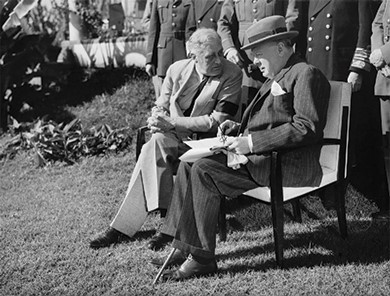
Prime Minister Winston Churchill and President Roosevelt met together multiple times during the war. One such conference was located in Casablanca, Morocco, in January 1943. Source: Wikimedia Commons
D-Day
A direct assault on Nazi Germany’s “Fortress Europe” was necessary for final victory. On June 6, 1944, Allied forces stormed the beaches of northern France on D-day. Beginning at 6:30 a.m., some twenty-four thousand British, Canadian, and American troops waded ashore along a fifty-mile piece of the Normandy coast. Well over a million troops followed their lead. German forces on the hills and cliffs above shot at them, and once they reached the beach, they encountered barbed wire and land mines. More than ten thousand Allied soldiers were wounded or killed during the assault. Following the establishment of beachheads at Normandy, it took months of difficult fighting before Paris was liberated on August 20, 1944. The invasion did succeed in diverting German forces from the eastern front to the western front, relieving some of the pressure on Stalin’s troops. By that time, however, Russian forces had already defeated the German army at Stalingrad, an event that many consider the turning point of the war in Europe and begun to push the Germans out of the Soviet Union.
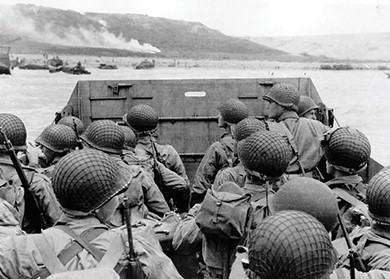
U.S. troops in a military landing craft approach the beach code-named “Omaha” on June 6, 1944. More than ten thousand soldiers were killed or wounded during the D-day assault along the coast of Normandy, France. Source: Wikimedia Commons
Nazi Germany was not ready to surrender, however. On December 16, in a surprise move, the Germans threw nearly a quarter-million men at the Western Allies in an attempt to divide their armies and encircle major elements of the American forces. The struggle, known as the Battle of the Bulge, raged until the end of January. Some ninety thousand Americans were killed, wounded, or lost in action. Nevertheless, the Germans were turned back, and Hitler’s forces were so spent that they could never again mount offensive operations.
By April 1945, Soviet forces had reached Berlin, and both the U.S. and British Allies were pushing up against Germany’s last defenses in the western part of the nation. Hitler committed suicide on April 30, 1945. On May 8, 1945, Germany surrendered. The war in Europe was over, and the Allies and liberated regions celebrated the end of the long ordeal. Germany was thoroughly defeated; its industries and cities were badly damaged.
|
|
MY STORY |
|
General Eisenhower on Winning a War Promoted to the level of one-star general just before the attack on Pearl Harbor, Dwight D. Eisenhower (pictured below) had never held an active command position above the level of a battalion and was not considered a potential commander of major military operations. However, after he was assigned to the General Staff in Washington, DC, he quickly rose through the ranks and, by late 1942, was appointed commander of the North African campaign.
Excerpts from General Eisenhower’s diary reveal his dedication to the war effort. He continued to work despite suffering a great personal loss. General McNaughton (commanding Canadians in Britain) came to see me. He believes in attacking in Europe (thank God). He’s over here in an effort to speed up landing craft production and cargo ships. Has some d___ good ideas. Sent him to see Somervell and Admiral Land. How I hope he can do something on landing craft. (March 9, 1942) Father dies this morning. Nothing I can do but send a wire. … Gradually some of the people with whom I have to deal are coming to agree with me that there are just three “musts” for the Allies this year: hold open the line to England and support her as necessary, keep Russia in the war as an active participant; hold the India-Middle East buttress between Japs and Germans. All this assumes the safety from major attack of North America, Hawaii, and Caribbean area. We lost eight cargo ships yesterday. That we must stop, because any effort we make depends upon sea communication. (March 10, 1942) I have felt terribly. I should like so much to be with my Mother these few days. But we’re at war. And war is not soft, it has no time to indulge even the deepest and most sacred emotions. I loved my Dad. I think my Mother the finest person I’ve ever known. She has been the inspiration for Dad’s life and a true helpmeet in every sense of the word. I’m quitting work now, 7:30 p.m. I haven’t the heart to go on tonight. (March 11, 1942) |
|
Confronting the Holocaust
The Holocaust, Hitler’s plan to kill the Jews of Europe, had begun as early as 1933, with the construction of Dachau, the first of more than forty thousand camps for incarcerating Jews, submitting them to forced labor, or exterminating them. Eventually, six extermination camps were established between 1941 and 1945 in Polish territory.
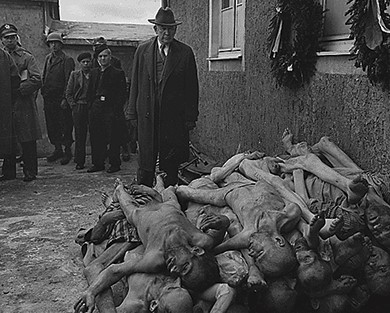
A U.S. senator, and member of a congressional committee investigating Nazi atrocities, views the evidence firsthand at Buchenwald concentration camp near Weimar, Germany, in the summer of 1945. Source: Wikimedia Commons
Jewish men, women, and children from throughout Europe were transported to these camps in Germany and other areas under Nazi control. Although the majority of the people in the camps were Jews, the Nazis sent Roma (gypsies), gays and lesbians, Jehovah’s Witnesses, and political opponents to the camps as well. Most of those sent to the extermination camps were killed upon arrival with poisoned gas. Ultimately, some eleven million people died in the camps.
|
|
MY STORY |
|
Felix L. Sparks on the Liberation of Dachau The horrors of the concentration camps remained with the soldiers who liberated them long after the war had ended. Below is an excerpt of the recollection of one soldier. Our first experience with the camp came as a traumatic shock. The first evidence of the horrors to come was a string of forty railway cars on a railway spur leading into the camp. Each car was filled with emaciated human corpses, both men and women. A hasty search by the stunned infantry soldiers revealed no signs of life among the hundreds of still bodies, over two thousand in all. It was in this atmosphere of human depravity, degradation and death that the soldiers of my battalion then entered the camp itself. … As we approached the confinement area, the scene numbed my senses. Dante’s Inferno seemed pale compared to the real hell of Dachau. A row of small cement structures near the prison entrance contained a coal-fired crematorium, a gas chamber, and rooms piled high with naked and emaciated corpses. As I turned to look over the prison yard with unbelieving eyes, I saw a large number of dead inmates lying where they has fallen in the last few hours or days before our arrival. Since all of the bodies were in various stages of decomposition, the stench of death was overpowering. The men of the 45th Infantry Division were hardened combat veterans. We had been in combat almost two years at that point. While we were accustomed to death, we were not able to comprehend the type of death that we encountered at Dachau. —Felix L. Sparks, remarks at the U.S. Holocaust Museum, May 8, 1995 |
|
YALTA AND PREPARING FOR VICTORY
The last time the Big Three met was in early February 1945 at Yalta in the Soviet Union. Roosevelt was sick, and Stalin’s armies were pushing the German army back towards Berlin from the east. Churchill and Roosevelt thus had to accept a number of compromises that strengthened Stalin’s position in eastern Europe. In particular, they agreed to allow the Communist government installed by the Soviet Union in Poland to remain in power until free elections took place. For his part, Stalin reaffirmed his commitment, first voiced at Tehran, to enter the war against Japan following the surrender of Germany. He also agreed that the Soviet Union would participate in the United Nations, a new peacekeeping body intended to replace the League of Nations. The Big Three left Yalta with many details remaining unclear, planning to finalize plans for the treatment of Germany and the shape of postwar Europe at a later conference. However, Roosevelt did not live to attend the next meeting. He died on April 12, 1945, and Harry S. Truman became president.
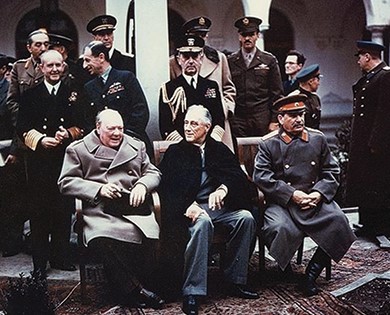
Prime Minister Winston Churchill, President Franklin Roosevelt, and Premier Joseph Stalin made final plans for the defeat of Nazi Germany at Yalta in February 1945. Source: Wikimedia Commons
The victorious Allies set about determining what to do to rebuild Europe at the Potsdam Summit Conference in July 1945. Attending the conference were Stalin, Truman, and Churchill, now the outgoing prime minister, as well as the new British prime minister, Clement Atlee. Plans to divide Germany and Austria, and their capital cities, into four zones—to be occupied by the British, French, Americans, and Soviets—a subject discussed at Yalta, were finalized. In addition, the Allies agreed to dismantle Germany’s heavy industry in order to make it impossible for the country to produce more armaments.
11.6 Section Summary
Upon entering the war, President Roosevelt believed that the greatest threat to the long-term survival of democracy and freedom would be a German victory. Hence, he entered into an alliance with British prime minister Winston Churchill and Soviet premier Joseph Stalin to defeat the common enemy while also seeking to lay the foundation for a peaceful postwar world in which the United States would play a major and permanent role. Appeasement and nonintervention had been proven to be shortsighted and tragic policies that failed to provide security and peace either for the United States or for the world. With the aid of the British, the United States invaded North Africa and from there invaded Europe by way of Italy. However, the cross-channel invasion of Europe through France that Stalin had long called for did not come until 1944, by which time the Soviets had turned the tide of battle in eastern Europe. The liberation of Hitler’s concentration camps forced Allied nations to confront the grisly horrors that had been taking place as the war unfolded. The Big Three met for one last time in February 1945, at Yalta, where Churchill and Roosevelt agreed to several conditions that strengthened Stalin’s position. They planned to finalize their plans at a later conference, but Roosevelt died two months later.
11.7 The Pacific Theater and the Atomic Bomb
Learning Objectives
By the end of this section, you will be able to:
- Discuss the strategy employed against the Japanese and some of the significant battles of the Pacific campaign
- Describe the effects of the atomic bombs on Hiroshima and Nagasaki
- Analyze the decision to drop atomic bombs on Japan
Japanese forces won a series of early victories against Allied forces from December 1941 to May 1942. They seized Guam and Wake Island from the United States and streamed through Malaysia and Thailand into the Philippines and through the Dutch East Indies. By February 1942, they were threatening Australia. The Allies turned the tide in May and June 1942, at the Battle of Coral Sea and the Battle of Midway. The Battle of Midway witnessed the first Japanese naval defeat since the nineteenth century. Shortly after the American victory, U.S. forces invaded Guadalcanal and New Guinea. Slowly, throughout 1943, the United States engaged in a campaign of “island hopping,” gradually moving across the Pacific to Japan. In 1944, the United States, seized Saipan and won the Battle of the Philippine Sea. Progressively, American forces drew closer to the strategically important targets of Iwo Jima and Okinawa.
THE PACIFIC CAMPAIGN
During the 1930s, Americans had caught glimpses of Japanese armies in action and grew increasingly sympathetic towards war-torn China. Stories of Japanese atrocities bordering on genocide and the shock of the attack on Pearl Harbor intensified racial animosity toward the Japanese. Wartime propaganda portrayed Japanese soldiers as uncivilized and barbaric, sometimes even inhuman.
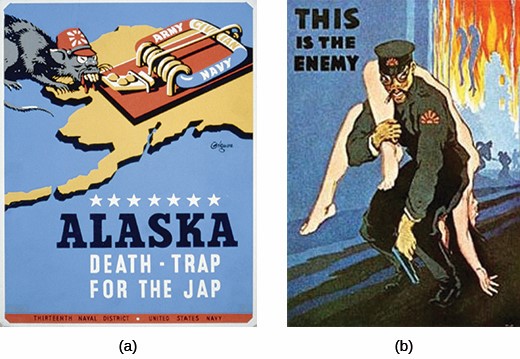
Anti-Japanese propaganda often portrayed the Japanese as inhuman (a). In addition to emphasizing the supposed apish features of the Japanese (b), this poster depicts the victim as a white woman, undoubtedly, to increase American horror even more. Source: Wikimedia Commons
In the Pacific, General Douglas MacArthur and the Allied forces pursued an island-hopping strategy that bypassed certain island strongholds held by the Japanese that were of little or no strategic value. By seizing locations from which Japanese communications and transportation routes could be disrupted or destroyed, the Allies advanced towards Japan without engaging the thousands of Japanese stationed on garrisoned islands.
By February 1945, American forces had reached the island of Iwo Jima. Iwo Jima was originally meant to serve as a forward air base for fighter planes, providing cover for long-distance bombing raids on Japan. Two months later, an even larger engagement, the hardest fought and bloodiest battle of the Pacific theater, took place as American forces invaded Okinawa. The battle raged from April 1945 well into July 1945; the island was finally secured at the cost of seventeen thousand American soldiers killed and thirty-six thousand wounded. Japanese forces lost over 100,000 troops. Perhaps as many as 150,000 civilians perished as well.
DROPPING THE ATOMIC BOMB
All belligerents in World War II sought to develop powerful and devastating weaponry. As early as 1939, German scientists had discovered how to split uranium atoms, the technology that would ultimately allow for the creation of the atomic bomb. Albert Einstein, who had emigrated to the United States in 1933 to escape the Nazis, urged President Roosevelt to launch an American atomic research project, and Roosevelt agreed to do so, with reservations. In late 1941, the program received its code name: the Manhattan Project. Located at Los Alamos, New Mexico, the Manhattan Project ultimately employed 150,000 people and cost some $2 billion. In July 1945, the project’s scientists successfully tested the first atomic bomb.
In the spring of 1945, the military began to prepare for the possible use of an atomic bomb by choosing appropriate targets. Suspecting that the immediate bomb blast would extend over one mile and secondary effects would include fire damage, a compact city of significant military value with densely built frame buildings seemed to be the best target. Eventually, the city of Hiroshima, the headquarters of the Japanese Second Army, and the communications and supply hub for all of southern Japan, was chosen. Nagasaki, an industrial center producing war materiel and the largest seaport in southern Japan, was selected as a secondary target.
The Enola Gay, a B-29 bomber named after its pilot’s mother, dropped an atomic bomb known as “Little Boy” on Hiroshima at 8:15 a.m. Monday morning, August 6, 1945. A huge mushroom cloud rose above the city. Survivors sitting down for breakfast or preparing to go to school recalled seeing a bright light and then being blown across the room. The immense heat of the blast melted stone and metal and ignited fires throughout the city. One man later recalled watching his mother and brother burn to death as fire consumed their home. A female survivor, a child at the time of the attack, remembered finding the body of her mother, which had been reduced to ashes and fell apart as she touched it. Two-thirds of the buildings in Hiroshima were destroyed. Within an hour after the bombing, radioactive “black rain” began to fall. Approximately seventy thousand people died in the original blast. The same number would later die of radiation poisoning. When Japan refused to surrender, a second atomic bomb, named Fat Man, was dropped on Nagasaki on August 9, 1945. At least sixty thousand people were killed at Nagasaki. It is impossible to say with certainty how many died in the two attacks; the heat of the bomb blasts incinerated or vaporized many of the victims.
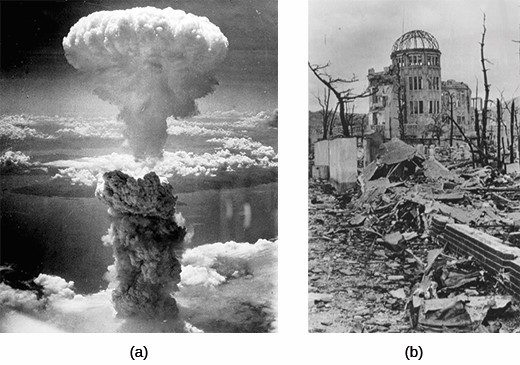
According to estimates, the atomic bombs dropped on Hiroshima and Nagasaki (a) together killed anywhere from 125,000 to over 250,000 people. The so-called Genbaku (A-Bomb) Dome, now the Hiroshima Peace Memorial, was the only building left standing near the Hiroshima bomb’s hypocenter (b). Source: Wikimedia Commons
The decision to use nuclear weapons is widely debated. Why exactly did the United States deploy an atomic bomb? The fierce resistance that the Japanese forces mounted during their early campaigns led American planners to believe that any invasion of the Japanese home islands would be exceedingly bloody. According to some estimates, as many as 250,000 Americans might die in securing a final victory. Such considerations undoubtedly influenced President Truman’s decision. Truman, who had not known about the Manhattan Project until Roosevelt’s death, also may not have realized how truly destructive it was. Indeed, some of the scientists who had built the bomb were surprised by its power. One question that has not been fully answered is why the United States dropped the second bomb on Nagasaki. As some scholars have noted, if Truman’s intention was to eliminate the need for a home island invasion, he could have given Japan more time to respond after bombing Hiroshima. He did not, however. The second bombing may have been intended to send a message to Stalin, who was becoming intransigent regarding postwar Europe. If it is indeed true that Truman had political motivations for using the bombs, then the destruction of Nagasaki might have been the first salvo of the Cold War with the Soviet Union. And yet, other historians have pointed out that the war had unleashed such massive atrocities against civilians by all belligerents—the United States included—that by the summer of 1945, the president no longer needed any particular reason to use his entire nuclear arsenal.
THE WAR ENDS
The bombs had the desired effect of getting Japan to surrender. Even before the atomic attacks, the conventional bombings of Japan, the defeat of its forces in the field, and the entry of the Soviet Union into the war had convinced the Imperial Council that they had to end the war. They had hoped to negotiate the terms of the peace, but Emperor Hirohito intervened after the destruction of Nagasaki and accepted unconditional surrender. Although many Japanese shuddered at the humiliation of defeat, most were relieved that the war was over. Japan’s industries and cities had been thoroughly destroyed, and the immediate future looked bleak as they awaited their fate at the hands of the American occupation forces.
The victors had yet another nation to rebuild and reform, but the war was finally over. Following the surrender, the Japanese colony of Korea was divided along the thirty-eighth parallel; the Soviet Union was given control of the northern half and the United States was given control of the southern portion. In Europe, as had been agreed upon at a meeting of the Allies in Potsdam in the summer of 1945, Germany was divided into four occupation zones that would be controlled by Britain, France, the Soviet Union, and the United States, respectively. The city of Berlin was similarly split into four. Plans were made to prosecute war criminals in both Japan and Germany. In October 1945, the United Nations was created. People around the world celebrated the end of the conflict, but America’s use of atomic bombs and disagreements between the United States and the Soviet Union at Yalta and Potsdam would contribute to ongoing instability in the postwar world.
11.7 Section Summary
The way in which the United States fought the war in the Pacific was fueled by fear of Japanese imperialistic aggression, as well as anger over Japan’s attack on Pearl Harbor and its mistreatment of its enemies. It was also influenced by a long history of American racism towards Asians that dated back to the nineteenth century. From hostile anti-Japanese propaganda to the use of two atomic bombs on Japanese cities, America’s actions during the Pacific campaign were far more aggressive than they were in the European theater. Using the strategy of island hopping, the United States was able to get within striking distance of Japan. Only once they adopted this strategy were the Allied troops able to turn the tide against what had been a series of challenging Japanese victories. The war ended with Japan’s surrender. The combined Allied forces had successfully waged a crusade against Nazi Germany, Italy, and Japan. The United States, forced to abandon a policy of nonintervention outside the Western Hemisphere, had been able to mobilize itself and produce the weapons and the warriors necessary to defeat its enemies. Following World War II, America would never again retreat from the global stage, and its early mastery of nuclear weapons would make it the dominant force in the postwar world.
Summary Timelines
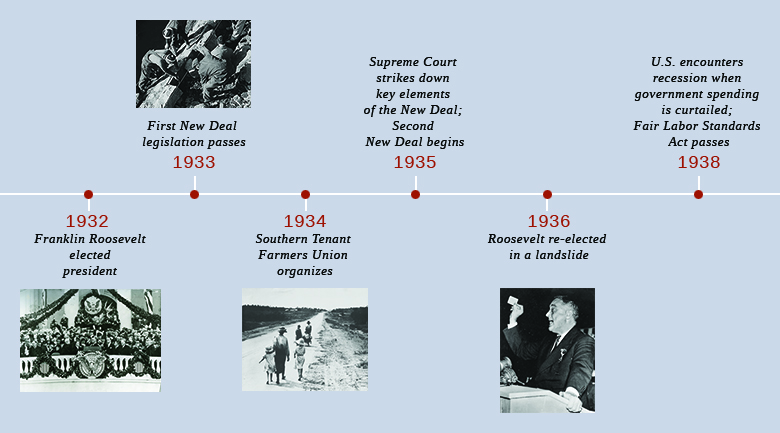
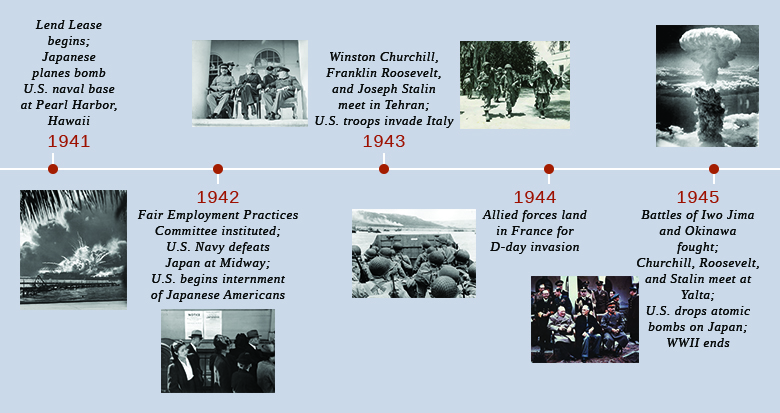
Chapter 11 Self-Test
Chapter 11 Key Terms Crossword Puzzle
Citations: This edited book is derivative of US History by P. Scott Corbett, et. al. CC BY 4.0. The original textbook is available at https://openstax.org/details/books/us-history
a public program for unemployed young men from relief families who were put to work on conservation and land management projects around the country
a federal agency tasked with the job of planning and developing the area through flood control, reforestation, and hydroelectric power projects
a program run by Harry Hopkins that provided jobs for over eight million Americans from its inception to its closure in 1943
a series of programs designed to help the population’s most vulnerable—the unemployed, those over age sixty-five, unwed mothers, and the disabled—through various pension, insurance, and aid programs
a political ideology that places a heightened focus on national unity, through dictatorial rule, and militarism
those who, for religious or philosophical reasons, refuse to serve in the armed forces
a symbol of female workers in the defense industries
a campaign by African Americans to win victory over the enemy overseas and victory over racism at home
flamboyant outfits favored by young African American and Mexican American men
the forced incarceration of the West Coast Japanese and Japanese American population into ten relocation centers for the greater part of World War II
the order given by President Roosevelt to relocate and detain people of Japanese ancestry, including those who were American citizens
the nickname given to the leaders of the three major Allied nations: Winston Churchill, Franklin Roosevelt, and Joseph Stalin
June 6, 1944, the date of the invasion of Normandy, France, by British, Canadian, and American forces, which opened a second front in Europe
the code name given to the research project that developed the atomic bomb
the plane that dropped the atomic bomb on Hiroshima
